Full of wild character, North West Tasmania offers a unique combination of remoteness and accessibility. It is home to the world’s largest expanse of cool temperate rainforest – the Tarkine Wilderness, Tasmania’s most iconic alpine wilderness – the Cradle Mountain, some of the most beautiful beaches in the state, underground caves, and one of Australia’s prettiest historic small towns – Stanley.
Because of its relative remoteness, north west Tasmania has fewer people and less traffic than the more popular east coast, yet it is easily accessible by a comprehensive road network.
A road trip to Tasmania’s north west is a journey of discovery and delight. From ancient rainforests and rugged coastline to idyllic beaches and quaint little towns, from the world’s freshest air and wildest rivers to Australia’s most delicious produce and seafood, north west Tasmania has it all.
And did I mention the wildlife? Between the Tarkine wilderness, the north west coast and the Cradle Mountain, north west Tassie is one of the best places to see iconic Australian animals in the wild.
Where is North West Tasmania?
Geographically, north west Tasmania encompasses the whole of the north west of the state, stretching from the mouth of the Peiman River on the southern fringes of the Tarkine Wilderness to the small coastal town of Port Sorrell and the Bass Strait.
What is North West Tasmania Famous for?
The region is famous for its pristine wilderness areas, including the Tarkine, stunning north west coastline, and fresh produce.
What Towns are in North West Tasmania?
Most towns in the north west are located along the Bass Strait and include Devonport, Burnie, Wynyard, Ulverstone, Penguin, Latrobe and Stanley as well as Smithton and Sheffield further inland.
Without further ado, here are the best places to visit on a north west Tasmania road trip. You can take this road trip in either direction: starting along the north west coast and then travelling inland, or start by exploring the wilder inland region and then head for the coast. We travelled from the wilderness to the coast, so this is how this itinerary is laid out.
I also provide links to more detailed guides to most of the destinations on this itinerary, where you can learn more about what to do and where to stay in each area.
Launceston
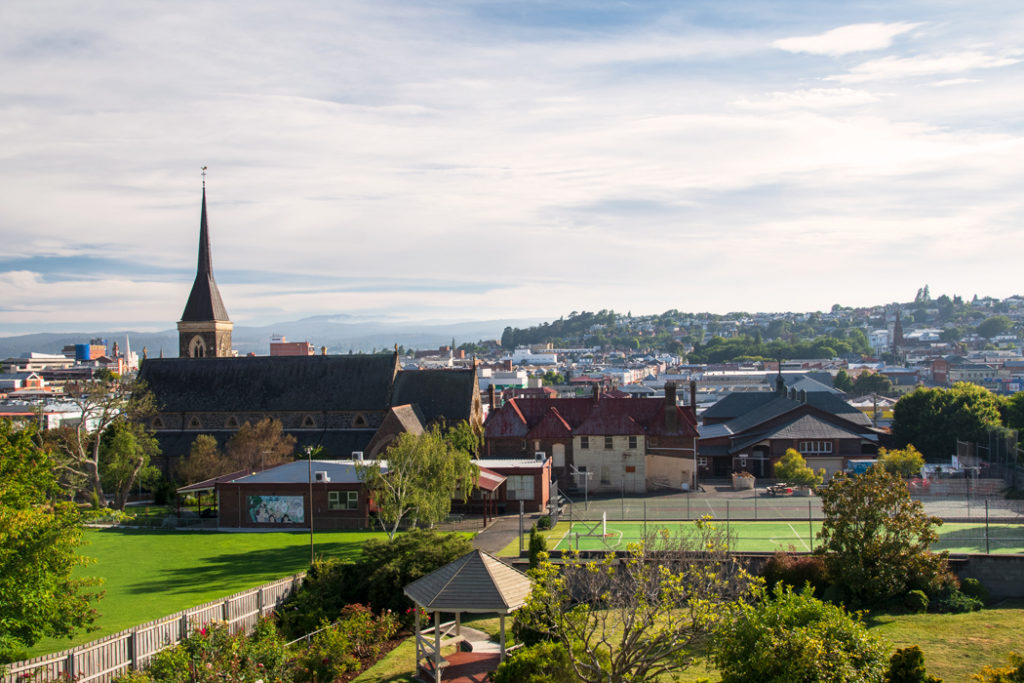
Launceston is the most convenient starting point for exploring north west Tasmania. We flew into Launceston airport in the early afternoon, picked up our rental car and were at Cradle Mountain in time for a late afternoon walk. Whether you explore Launceston at the start or at the end of your road trip, here are some unmissable highlights to add to your itinerary.
Launceston is a lovely city that manages to have a buzzing atmosphere without being busy. It is small enough to explore on foot yet big enough to warrant a couple of days’ stay.
Launceston’s most iconic attraction is the Cataract Gorge, home to the world’s longest single-span chairlift, a suspension bridge, a swimming pool, a restaurant, and a network of walking trails. All within a 15-minute walk from the city centre. We visited the gorge in the late afternoon and walked back at night, and the gorge was even more striking than in the daylight.
Plus, you get to see some chubby Brushtail possums after dark. They seem to be more terrestrial in habits than their mainland cousins.
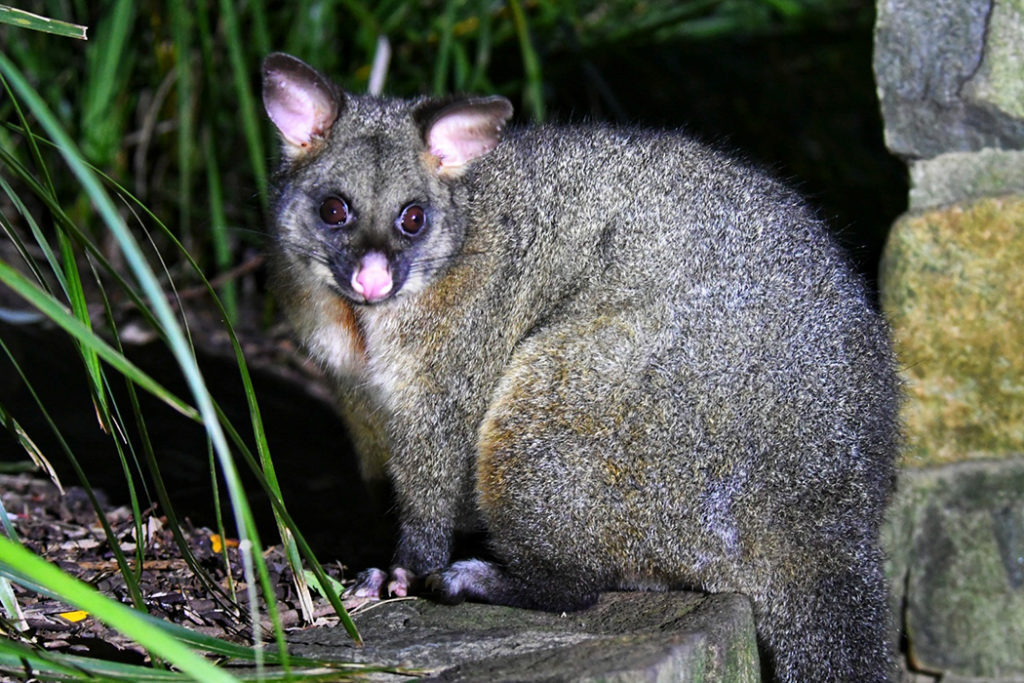
Another thing Launceston is known for is its thriving culinary scene. You haven’t really been to Launceston if you haven’t sampled some of Tasmania’s food specialties like truffles, cheese, wagyu beef, not to mention the state’s famously fresh seafood. Some of Launceston’s top restaurants to consider are Geronimo Aperitivo Bar and Restaurant, Stillwater, Grain of the Silos, and Josef Chromy Wines.
If you have more time in town, you might like to join a tour of Tamar Valley Wineries. This 6-hour tour takes you to 3 or 4 cellar doors and a gin distillery and includes lunch at one of the wineries.
Where to stay in Launceston
There are plenty of lovely hotels and cottages in Launceston, depending on your preference. There is the gorgeous Kurrajong House – the restored 1897 house with all the modern-day creature comforts and beautifully decorated rooms.
If you prefer the comfort and service of a luxury hotel, Peppers Silo has unbeatable water views. For something a little more low-key and budget-friendly, the Auldington Hotel has a gorgeous veranda with a beautiful city view. Or check all the accommodation options in Launceston available for your dates.
Sheffield
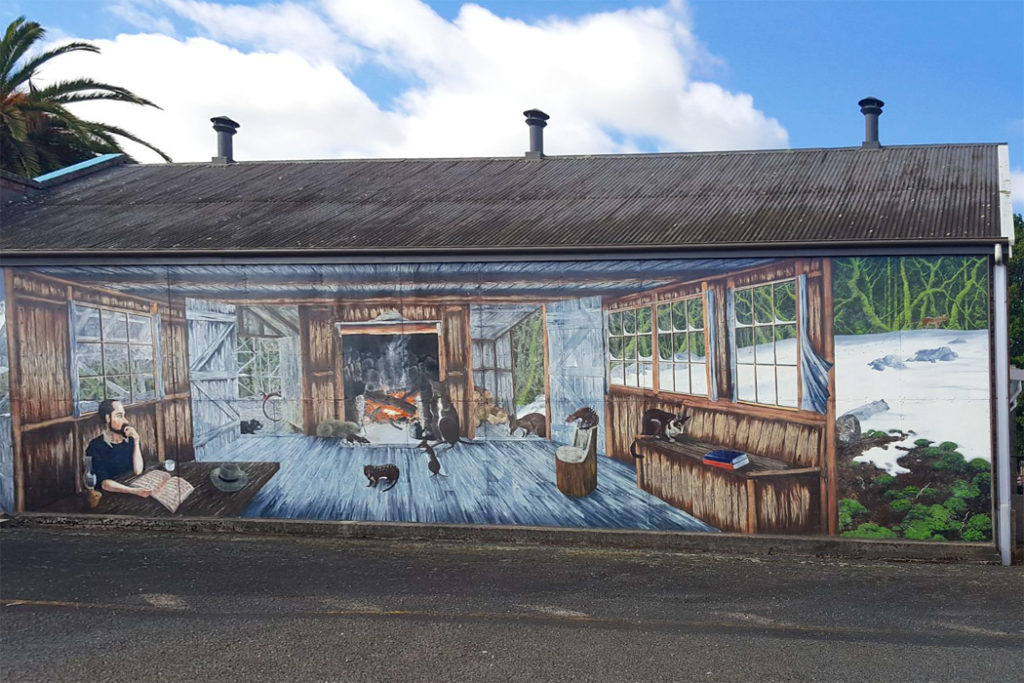
Once you are ready to hit the road, head for Cradle Mountain – it’s a 140 km drive, about 2 hours. There are a couple of options for a stopover along the way, depending on which road you choose. The most convenient and quickest route is via Sheffield (89 km from Launceston and 54 km to Cradle Mountain).
Lying in the foothills of Mount Roland, Sheffield is a quirky little town famous for its murals that cover every blank wall in town. Most of Sheffield’s 200 plus murals depict the town’s history and its native flora and fauna.
You could stop here for an hour to stretch your legs, enjoy the country town atmosphere, and check out some of the murals. Or if you take your street art seriously, you can take a self-guided mural tour by following this map by Sheffield Visitor Center.
Mole Creek Caves
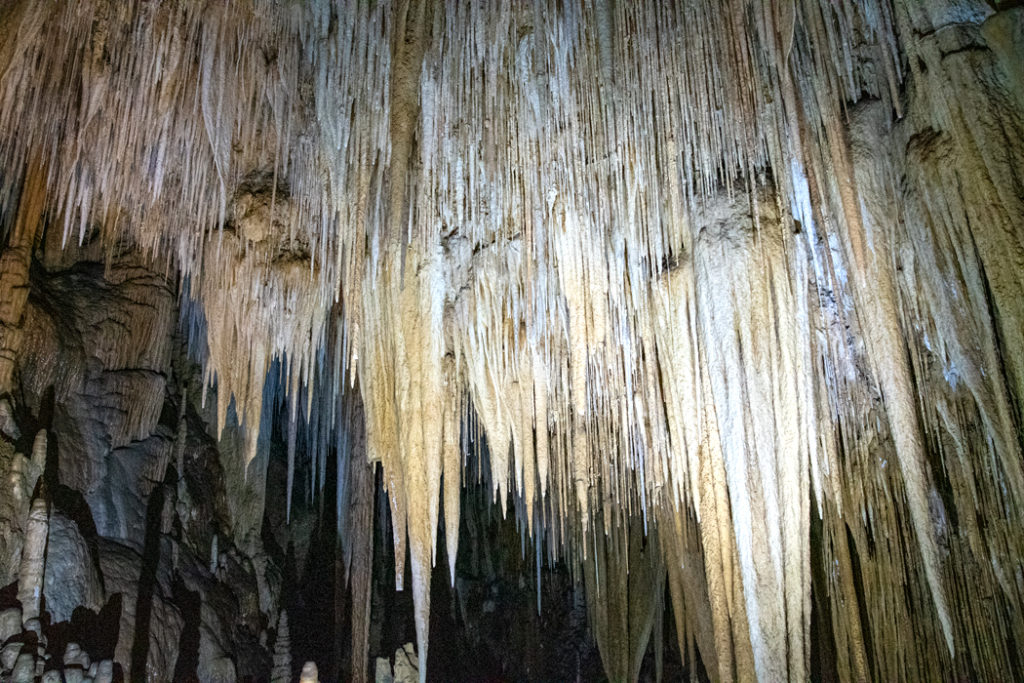
If street art and small towns are not your things, you can take an alternative, slightly longer route to Cradle Mountain via Mole Creek Caves – home to one of Tasmania’s most beautiful show caves – the Marakoopa Cave (88 km from Launceston and 72 km to Cradle Mountain). But as you choose between Sheffield and Mole Creek, keep in mind that you’ll have another opportunity to visit a cave on this itinerary – the underground Gunns Plains cave.
There are three options for guided tours at Mole Creek Caves (check current tour times): two for Marakoopa Cave and one for King Solomons Cave. The most impressive tour of the three is the Great Cathedral and Glow-worms Tour in Marakoopa Cave. It starts with a walk through the gorgeous Fern Glade to reach the cave entrance followed by a steep (but short) ascent up the stairway to the ‘Cathedral’.
And once you are in the Great Cathedral, you’ll be surrounded by the striking and delicate crystal formations of straws, flowstone and shawls with multicoloured bands created by traces of minerals in the water.
As with most caves, the temperature in Mole Creek caves is around 9 degrees, so make sure to bring a jumper.
Cradle Mountain
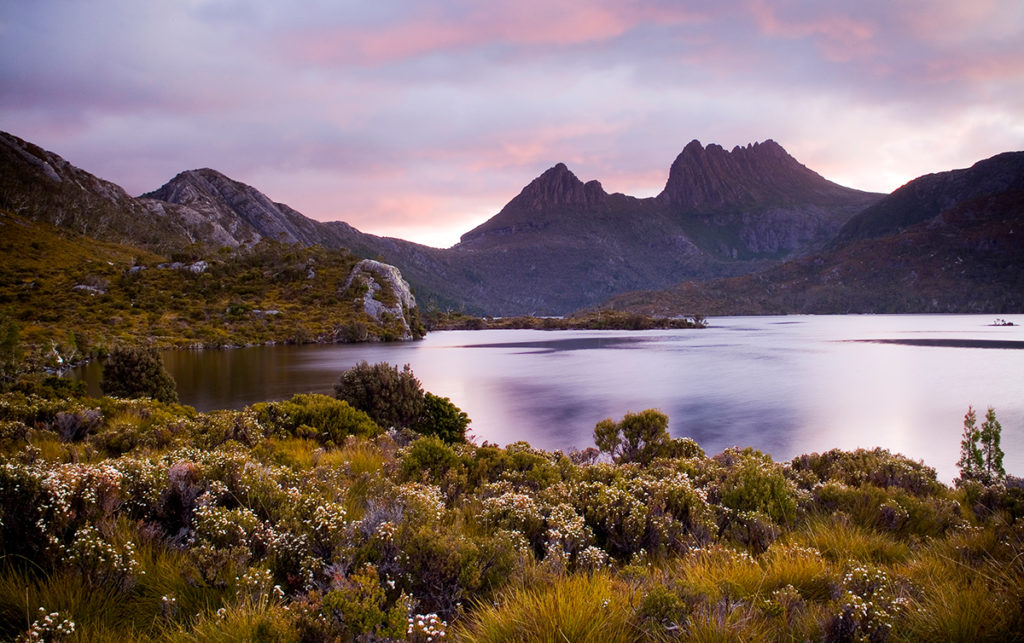
As interesting as the murals or the caves are, they pale in comparison to the stunning alpine wilderness of Cradle Mountain. Part of the Tasmanian Wilderness World Heritage Area and Cradle Mountain-Lake St. Clair National Park, Cradle Mountain is a magical world of mossy rainforests, spongy alpine grasslands, glacial lakes and jagged mountain peaks. No trip to Tasmania is complete without a visit to Cradle Mountain, even if it means packing a suitcase full of winter woollies for a summer vacation – the weather at Cradle Mountain is very unpredictable.
On top of the spectacular and very unique landscape, Cradle mountain is one of the best places in the state to see native Tasmanian wildlife. Wombats, Tasmanian Pademelons, Bennett’s Wallabies, and Echidnas are a common sight in the park and on the grounds of the lodges.
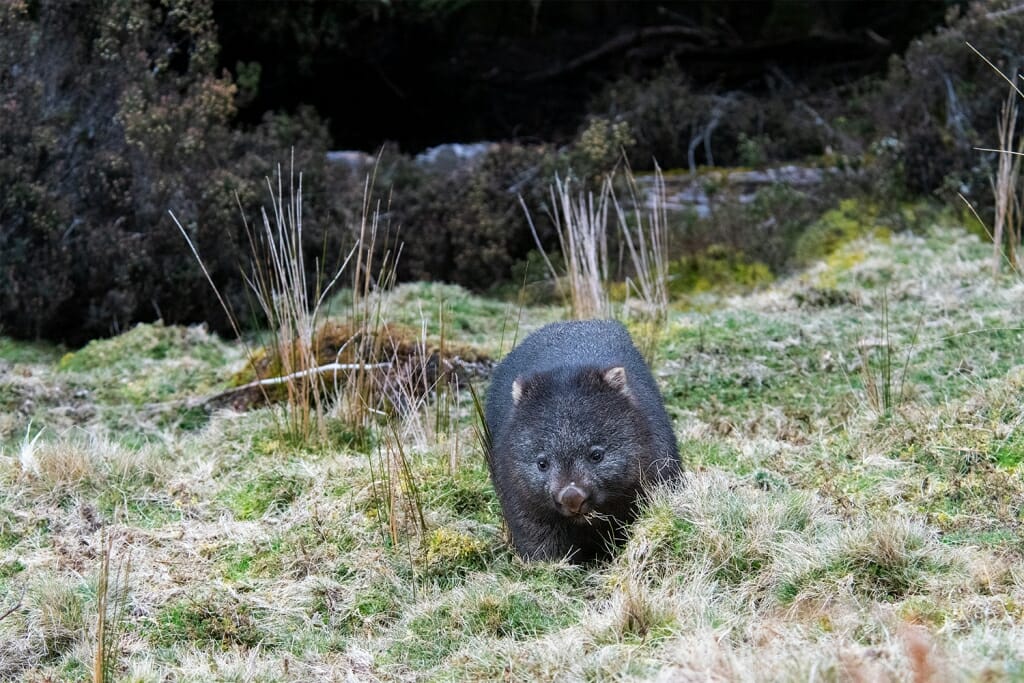
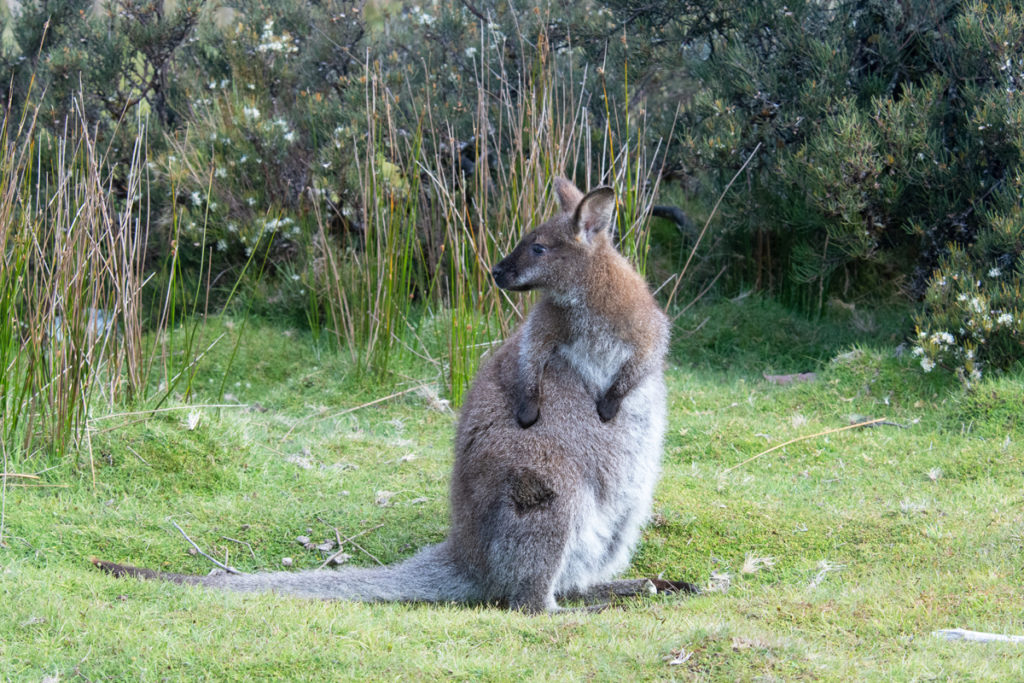
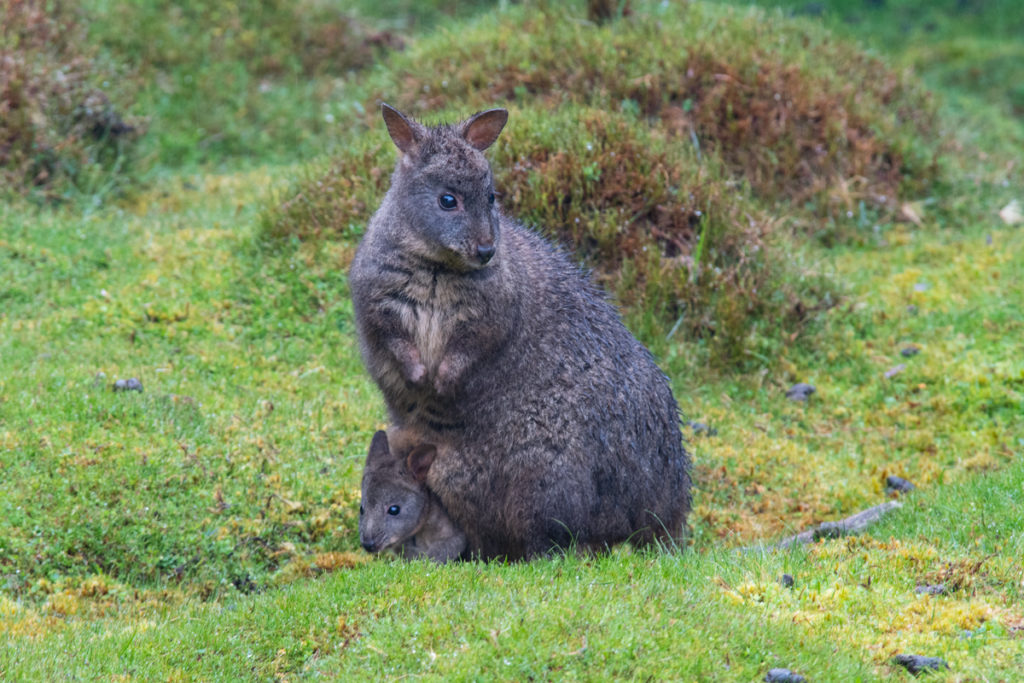
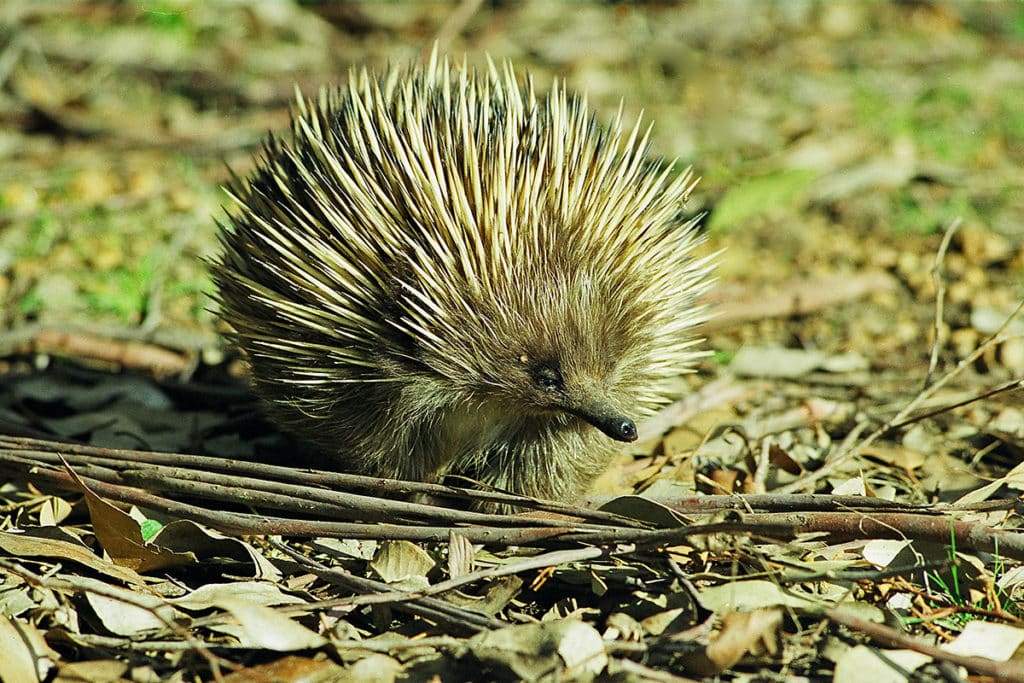
The most popular way to explore the alpine landscapes of Cradle Mountain is by hitting the walking trails. I recommend spending two days at Cradle Mountain and doing a few different walks to truly appreciate this unique corner of the world. To access the walks within the National Park, you’ll need to purchase your Park Pass ($25 for a day pass) at the visitor centre and jump on the free shuttle bus that takes you to the starting points of all the walks.
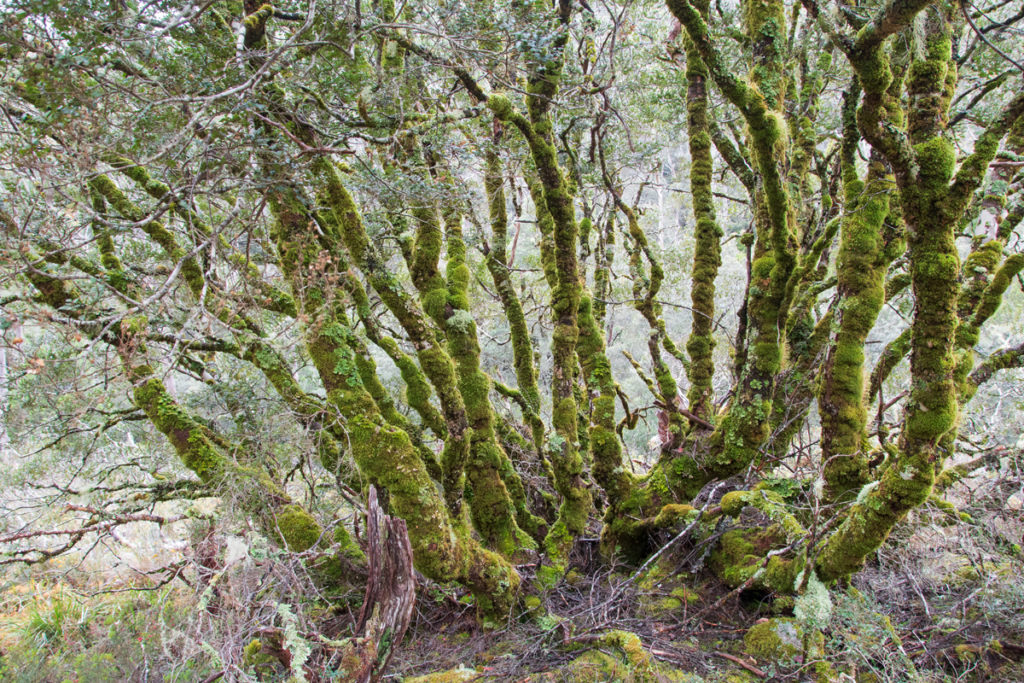
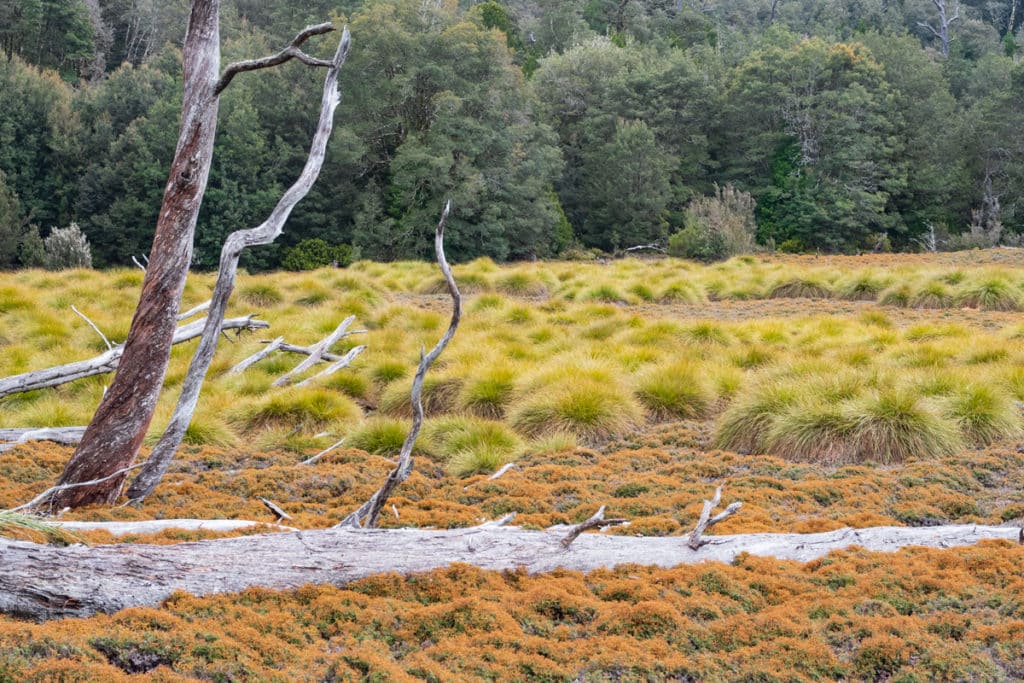
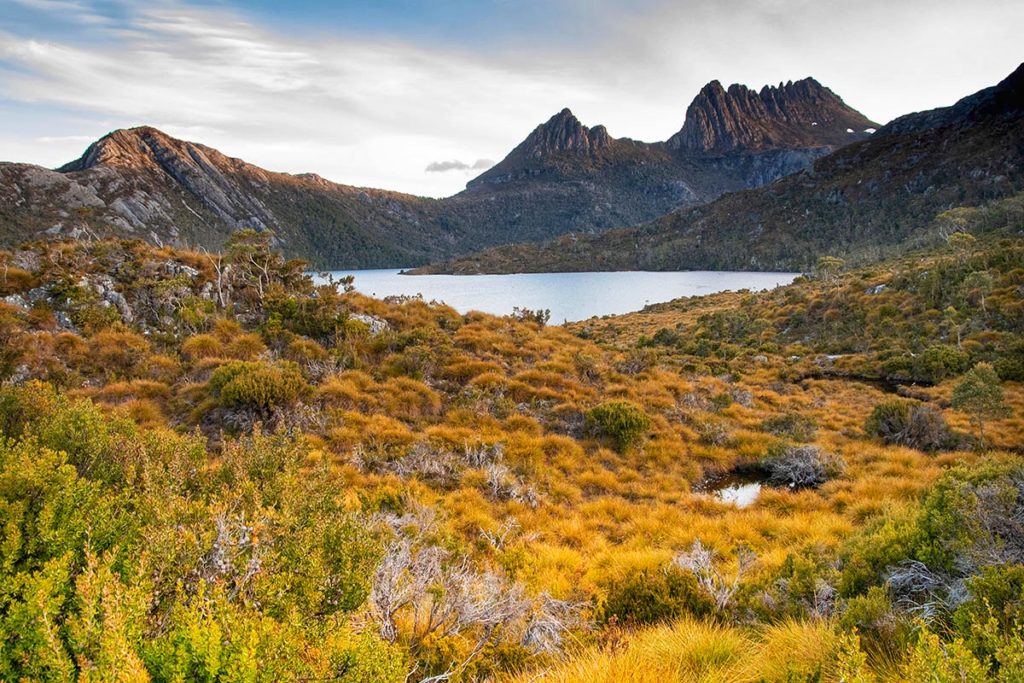
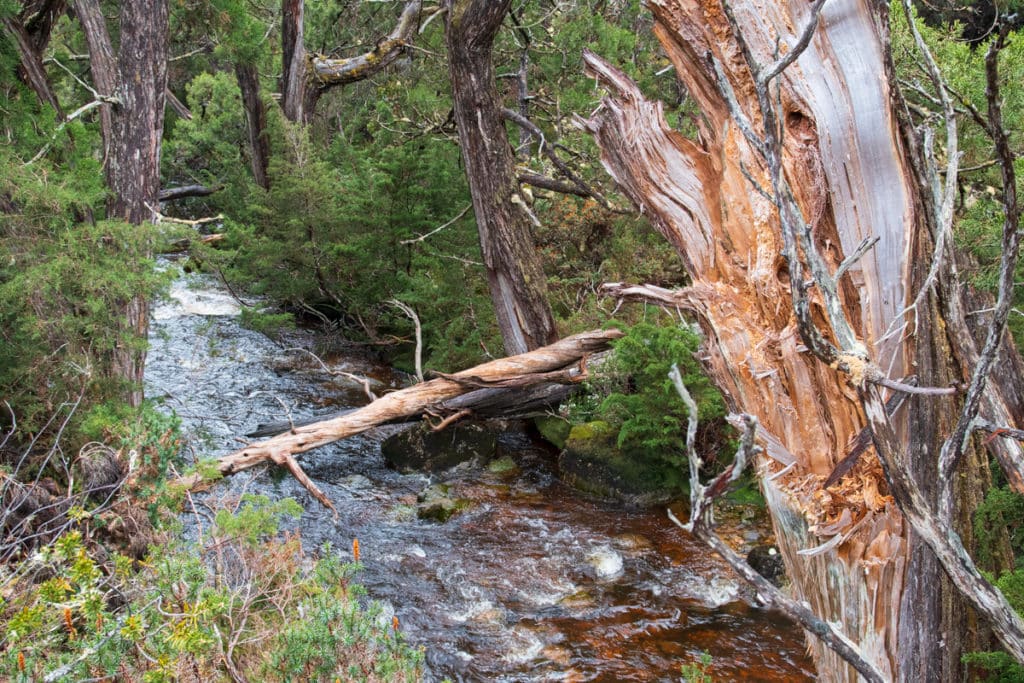
The most popular trail is the 6-km Dove Lake Circuit which takes you around a glacial lake lying in the shadow of Cradle Mountain. Another popular and easy trail, the 5.5-km Cradle Valley Boardwalk, meanders through grass plains, woodlands and across wooden bridges over the Dove River.
There are also some short walks just outside of the National Park that you shouldn’t miss. The Enchanted Walk and King Billy Walk are only 20 and 40 minutes, respectively, yet they make you feel like you stepped into a different world entirely. Both these walks take you through Tolkienesque mossy rainforest, where every surface and every tree trunk is covered in blankets of lush green moss and tendrils of lichen. For details about these walks and other adventures, check out my guide to Things to do in Cradle Mountain.
Where to stay in Cradle Mountain
There are five accommodation options at Cradle Mountain, all strung up along Cradle Mountain Road.
If you are looking to wrap yourself in comfort, stay at Peppers Cradle Mountain Lodge, or at Cradle Mountain Hotel. If you don’t mind self-catering, Cradle Mountain Highlanders and Cradle Mountain Wilderness Village offer self-contained timber-lined cottages that feature cosy interiors with fireplaces and fully stocked kitchens. And if you are looking for a budget-friendly option, Discovery Parks offer a range of self-contained dorm rooms, cabins and cottages.
Mountain Valley Wilderness Holidays
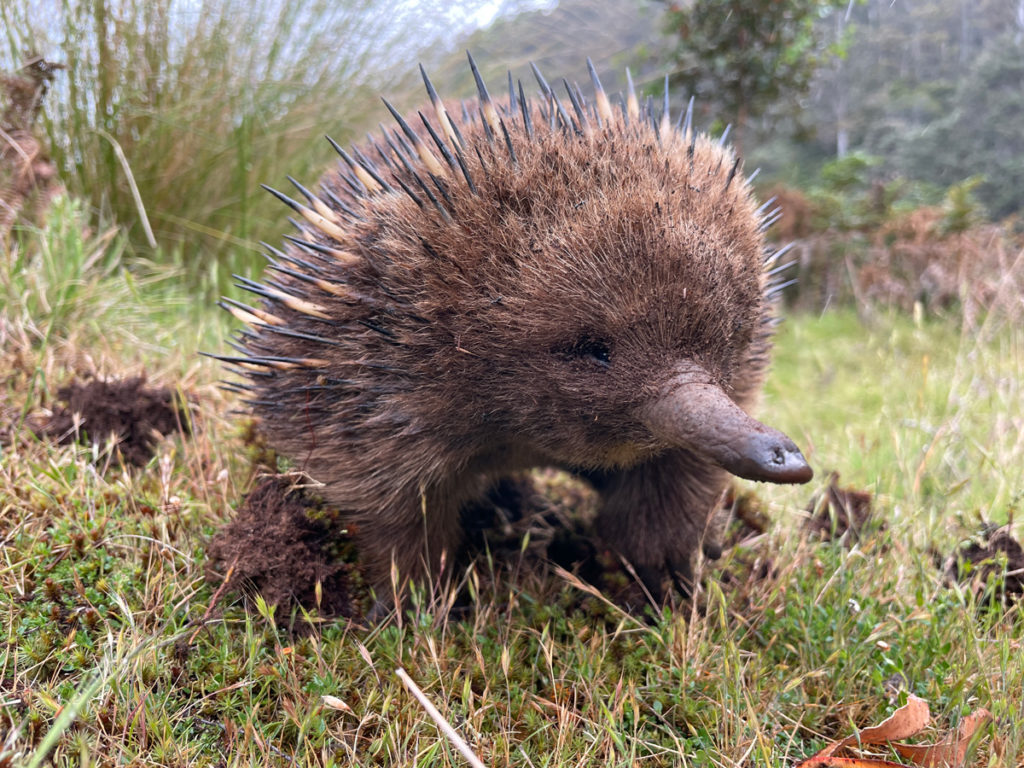
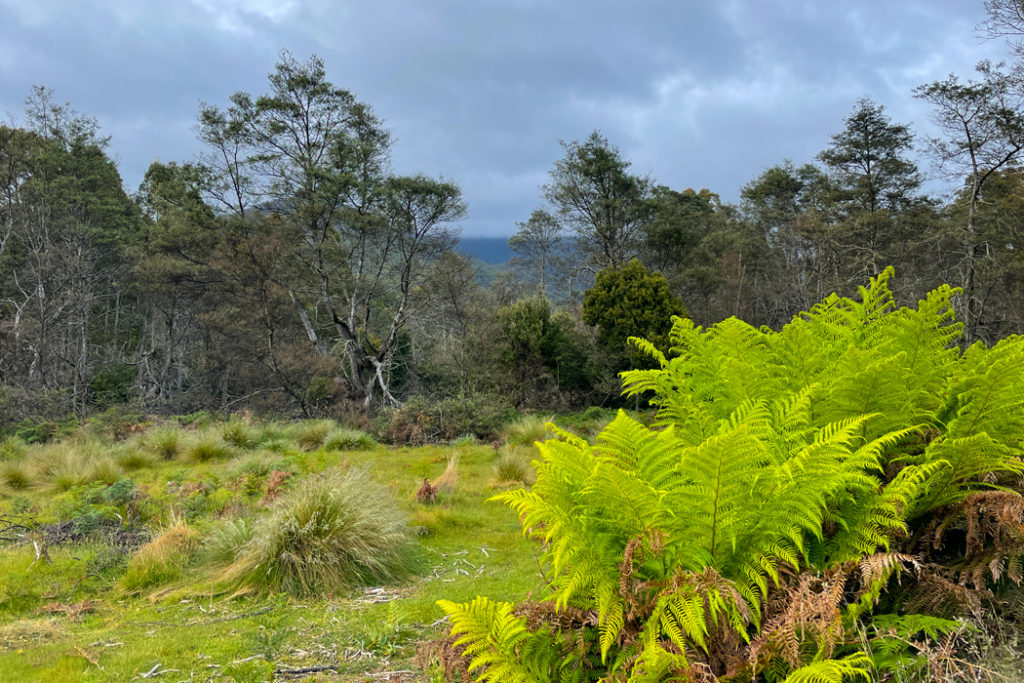
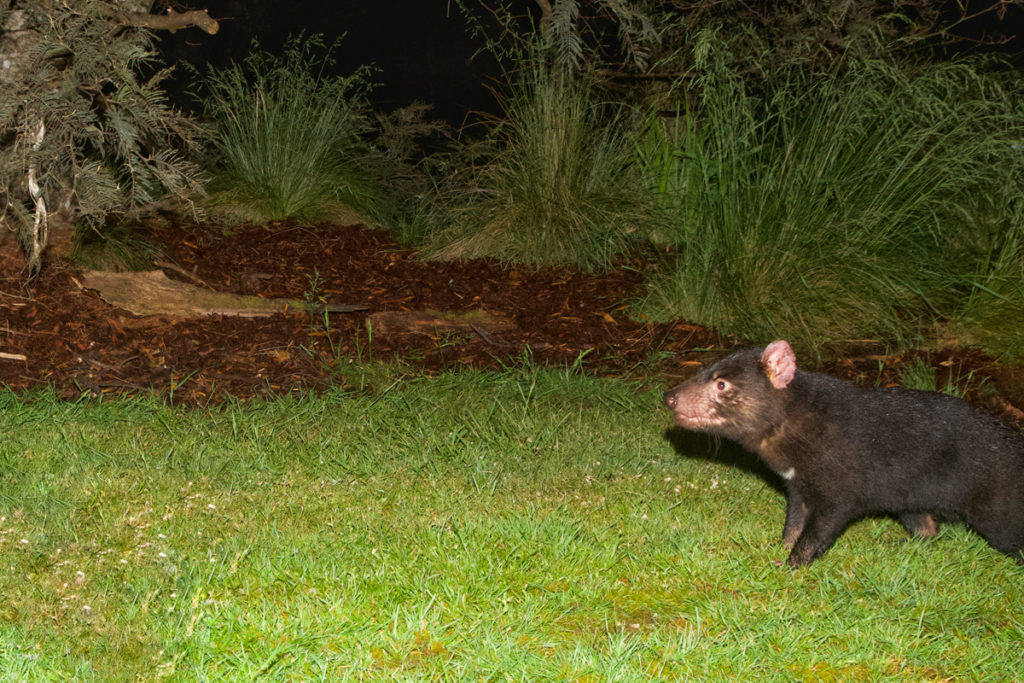
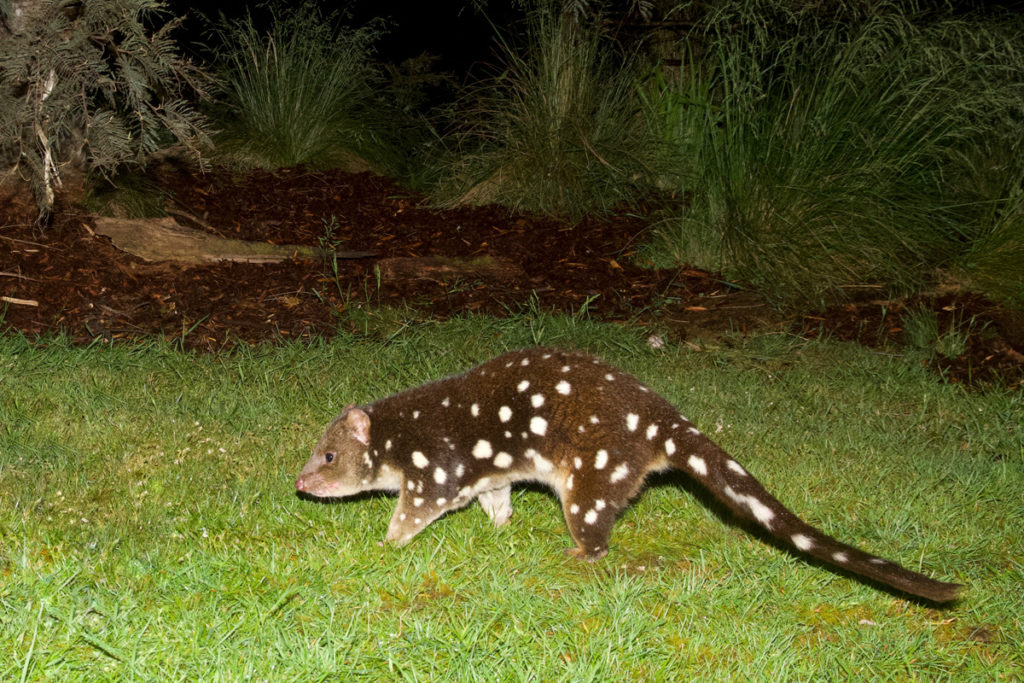
Mountain Valley Wilderness Holidays is the true hidden gem of north west Tasmania. Located 74 km from Cradle Mountain via Cradle Mountian and Castra roads (or 18km as the crow flies), this little-known Private Nature Reserve is the best place in the state to see the elusive Tasmania devil and Spotted-tailed quoll in the wild.
The reserve offers 6 cozy self-contained log cabins, each with an open log fire, electric blanket and reverse-cycle air conditioning. And the best part is that the cabins double up as wildlife hides – you get to watch the secretive carnivores visit your cabin after dark.
Apart from Tassie devils and Spotted-tailed quolls, Mountain Valley is a good place to see platypus, echidnas, Tasmanian pademelons, most of Tasmania’s endemic bird species, and even glowworms! Tucked away from the rest of the world in the Loongana Mountain range, this remote property is a wildlife watching paradise. You can read about our experience in my Mountain Valley Wilderness Holidays Review.
The minimum stay at Mountain Valley is 2 nights and there are plenty of attractions in the surrounding area to explore in your spare time.
Leven Canyon
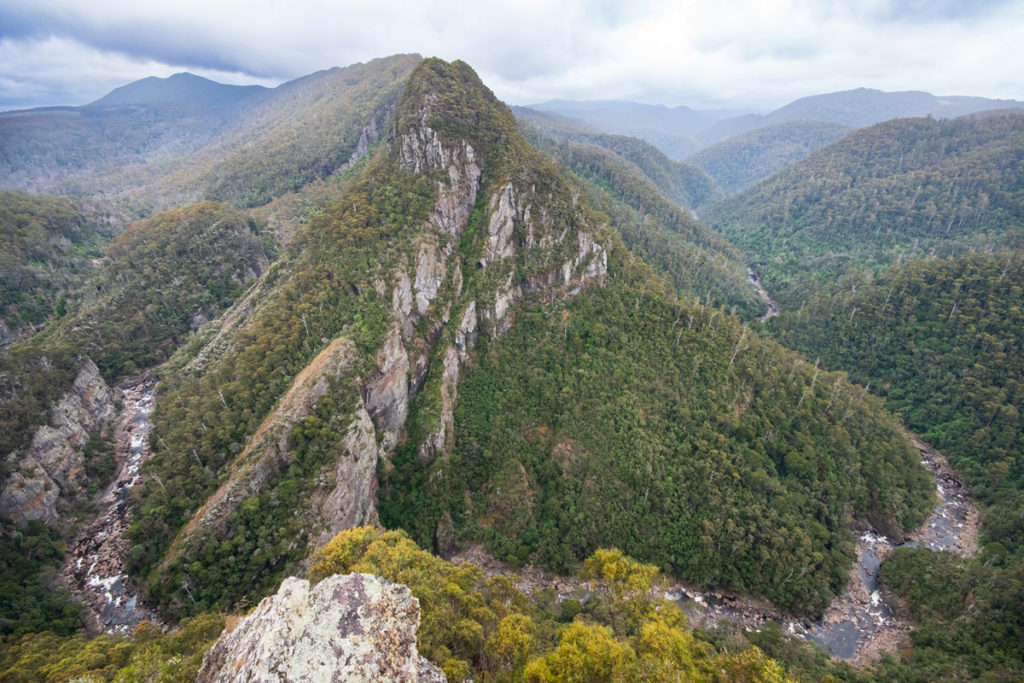
Just 7 km from Mountain Valley Wilderness Holidays, Leven Canyon is another hidden gem of the north west. It is one of the least known Tasmania’s Great Short Walks. The most incredible thing about Leven Canyon is the two lookouts that jut out from the canyon’s edge over the wild Leven River, meandering 250 meters below.
The Edge Lookout is located in the narrow section of the canyon with the Black Bluff mountain on the other side of the canyon staring right in your face. Because the canyon is narrow here, it appears even deeper than it is. That proximity and the ruggedness of the limestone cliffs make you feel like you are in an incredibly remote wild area when in truth you are only 15 minutes away from a car park and a picnic area.
Where the view from the Edge lookout is intimate and wild, the panorama at Cruickshanks lookout is vast and epic with forested mountains rolling towards the horizon as far as the eye can see.
Each lookout can be reached by a short walk, 30 and 20 minutes respectively. Or you can combine the two walks into a longer loop walk. You can find more details and photos of the walks in my guide to Leven Canyon. If you are not staying at Mountain Valley, you can visit Leven Canyon on a day trip from the coastal town of Ulverstone – 41km away.
Gunns Plains Caves
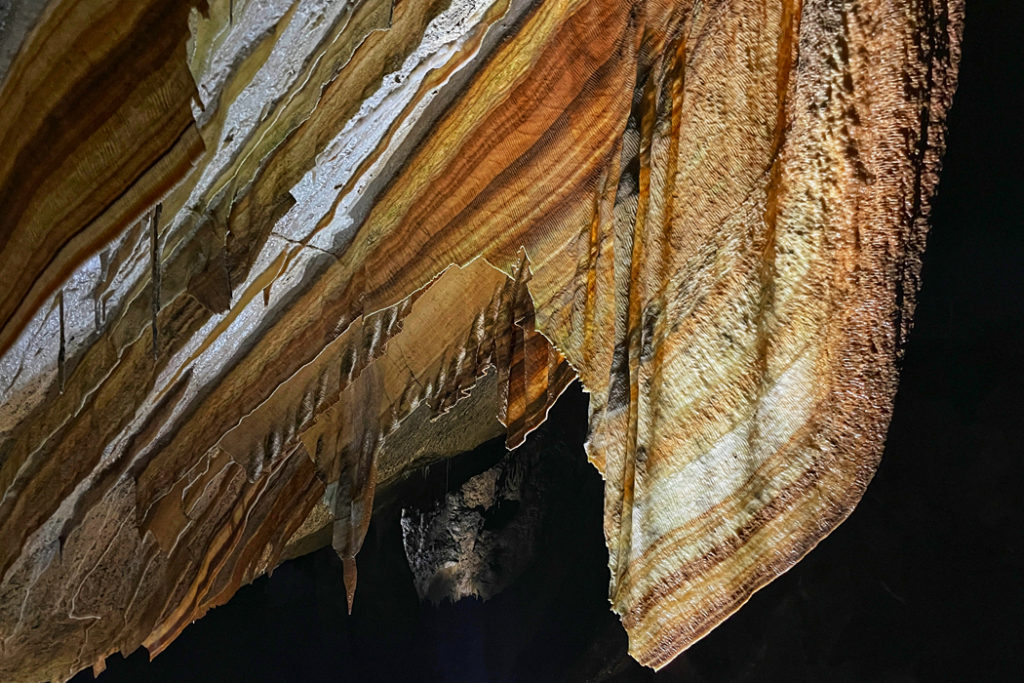
Just under 30 km from Leven Canyon, Gunns Plains Caves are a unique journey underground into the world of trickling water, a running stream, and dreamy crystal formations.
The only way to find Gunns Plains Caves is by following the road signs or your GPS. Nothing betrays their presence above ground. For all you know, you are just driving across pretty farmland. That’s the thing about north west Tasmania, there are so many hidden gems here but there is no fanfare announcing their existence. If you didn’t know these incredible sites were there, you would drive right past them. You get to feel like an explorer rather than a tourist here.
Once you reach Gunns Plains Caves car park, follow the path down the steps towards the reception located below the ground level. Here you can join a cave tour to explore the underground wonderland. Gunns Plains Cave is famous for its stunning calcite shawls – the sheet-like formations that form when water flows sideways. For more details, check my guide to Visiting Gunns Plains Caves.
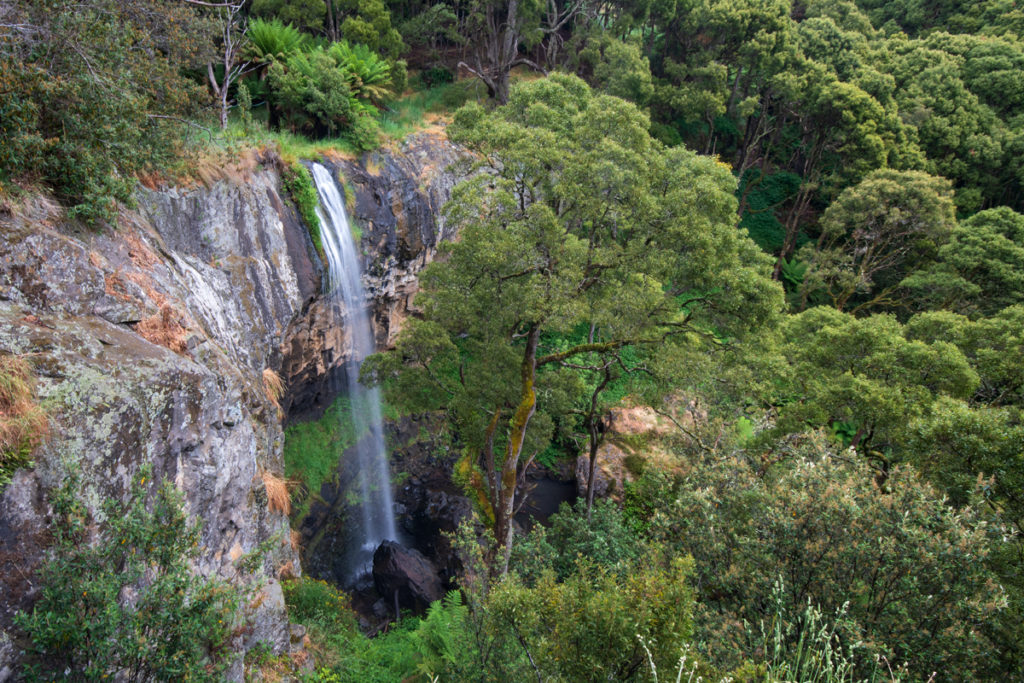
While you are in the area, make sure to check out Preston falls 9 km away on Raymond Road. It’s another lovely gem just a 10-minute walk from the road.
Stanley
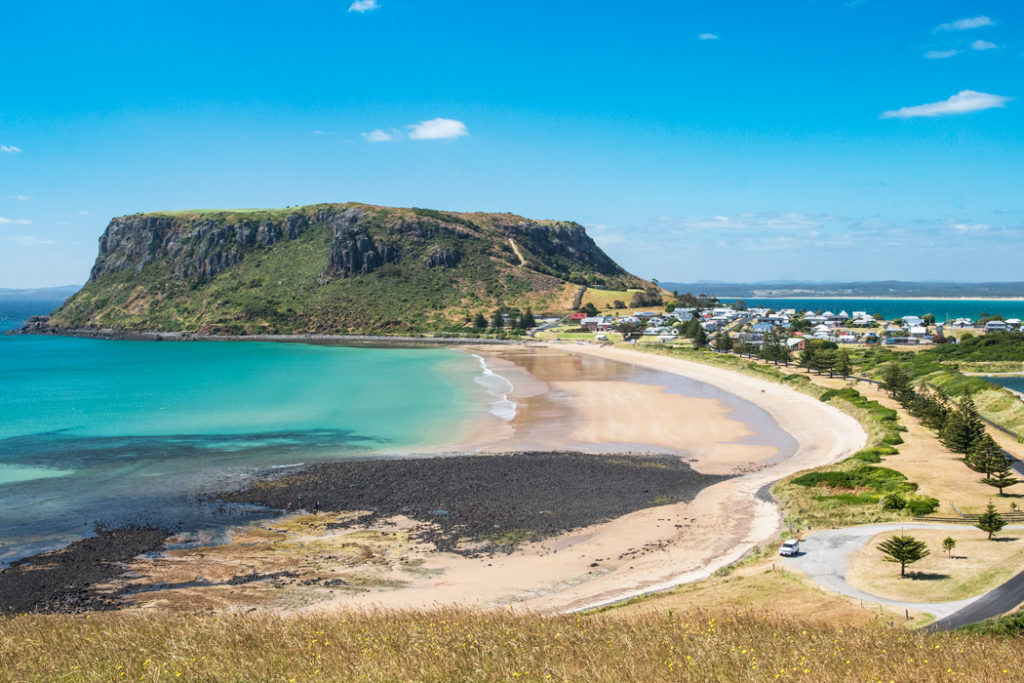
Stanley is my absolute favourite small town in Tasmania, if not in all of Australia. It is an adorable little town, 151 km from Mountain Valley or 103 km from Ulverstone, perched on a small piece of land that juts out into the Bass Strait on north-west coast. Lying at the foot of The Nut – a 150-m high flat-topped ancient volcano, Stanley has jaw-dropping coastal views and sandy beaches on both sides of town that would give Wineglass Bay a run for its money.
The town’s historic centre is a perfectly preserved colonial town with cute-as-a-button cottages, stately buildings, quaint boutiques, and cozy cafes. It is so authentically colonial that when the old-fashioned drama ‘The Light Between Oceans’ was filmed in town, all the filmmakers had to do was to cover the town’s roads with gravel and they had their 1920s set.
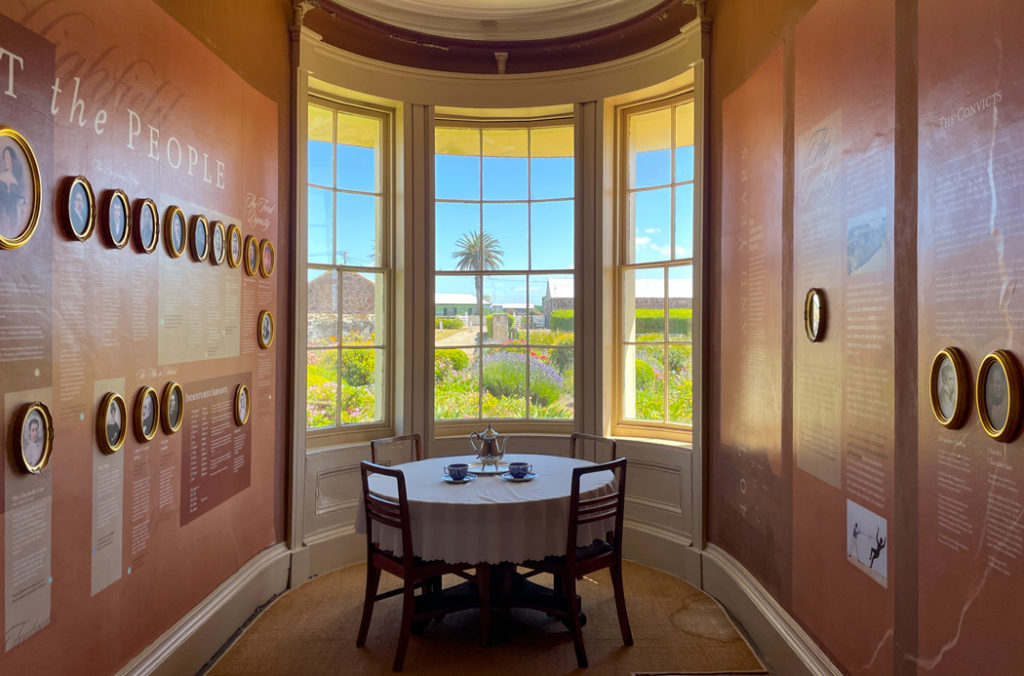
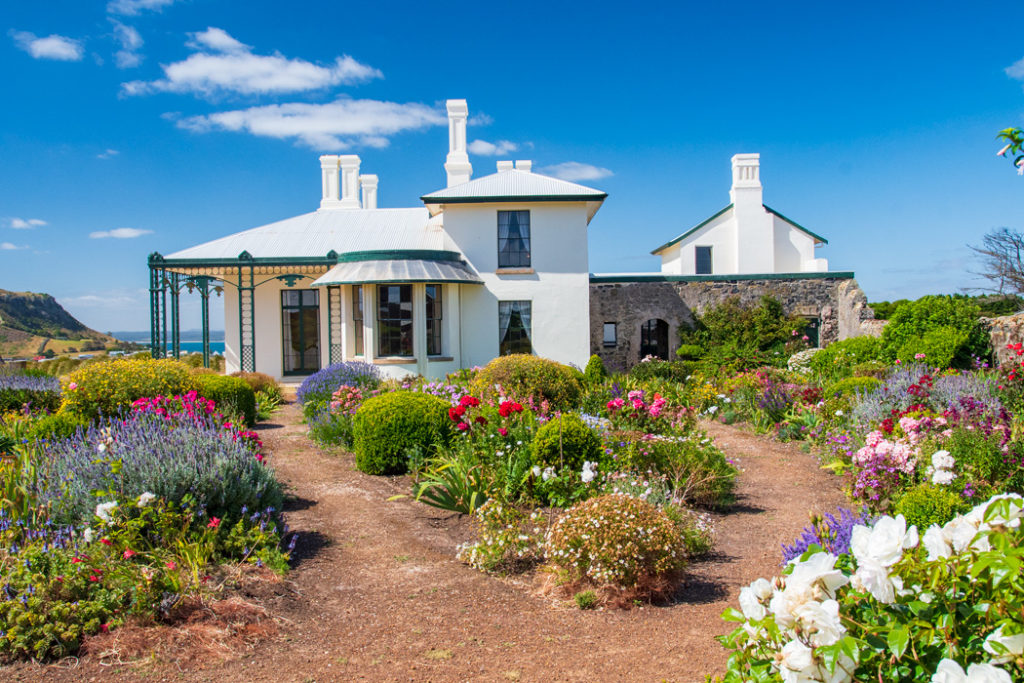
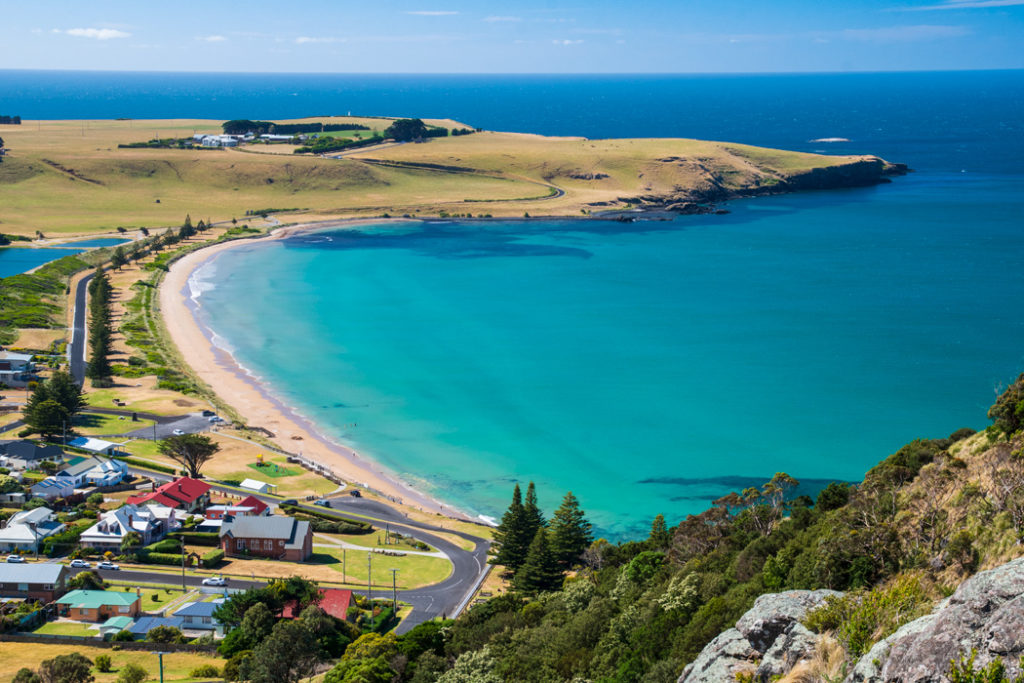
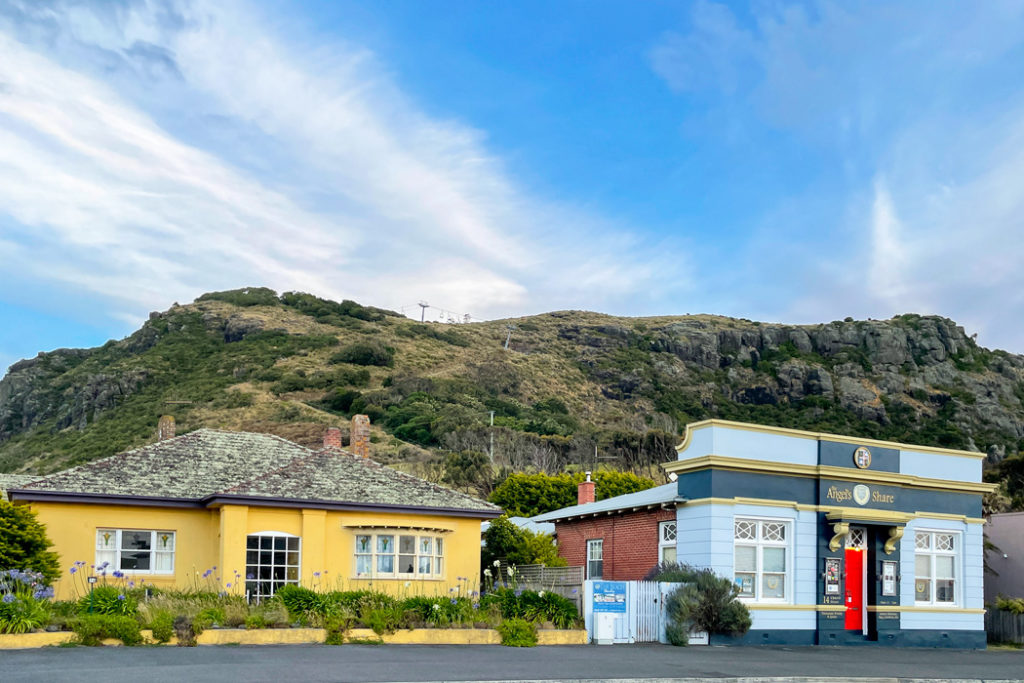
Despite its small size, Stanley is brimming with attractions and activities. You can climb The Nut (or take the chairlift up) and enjoy a birds-eye view of the coastline, visit the historic homestead at Highfield historic site, frolic on the gorgeous Godfreys beach, sample the region’s best seafood at Hursey’s Seafood, watch penguins emerge on the beach at night and finish your day in style at the local whiskey bar. For more ideas and inspiration, check my guide to Things to Do in Stanley.
But there is more to Stanley than the sum of its attractions. It’s hard to put a finger on it, but somehow Stanley’s peace and quiet make you feel utterly relaxed and deeply content. It is impossible not to fall in love with Stanley.
Where to stay in Stanley
If you are going to visit a historic town, you may as well stay in the historic centre of it! And there are quite a few adorable cottages along Church Street and Alexander Terrace. For a touch of luxury, consider Aston on Church Villa. For old-fashioned charm have a look at s Touchwood Cottages on Church Street. Want to be even closer to the beach? Then head to Beach Holiday Cottages. Or for something a little different, consider Stamps on Stanley apartments located in the Post Office.
The only two properties I’ll mention that are not in the historic centre are the stunning Ship Inn where each room is beautifully decorated in a different style and the Horizon Deluxe Apartments with their magnificent views of The Nut from a luxurious spa bath.
Tarkine Drive
On top of being a gorgeous little town, Stanley is also the gateway to the wildest part of north west Tasmania – the sunning Tarkine Wilderness. Affectionately referred to as the End of the World, the Tarkine wilderness contains one of the world’s largest and Australia’s last remaining single tract of temperate rainforest. Some of the trees in Tarkine rainforest are as old as the giants of the Southern Tasmanian forest.
You can explore the fringe of the Tarkine Wilderness on the striking and dramatic Tarkine Drive that takes you from ancient rainforests to the rugged coastline. There are dozens of lookouts and short walking trails along the drive, so allow at least two days for the drive – one for the rainforest section and one for the coast.
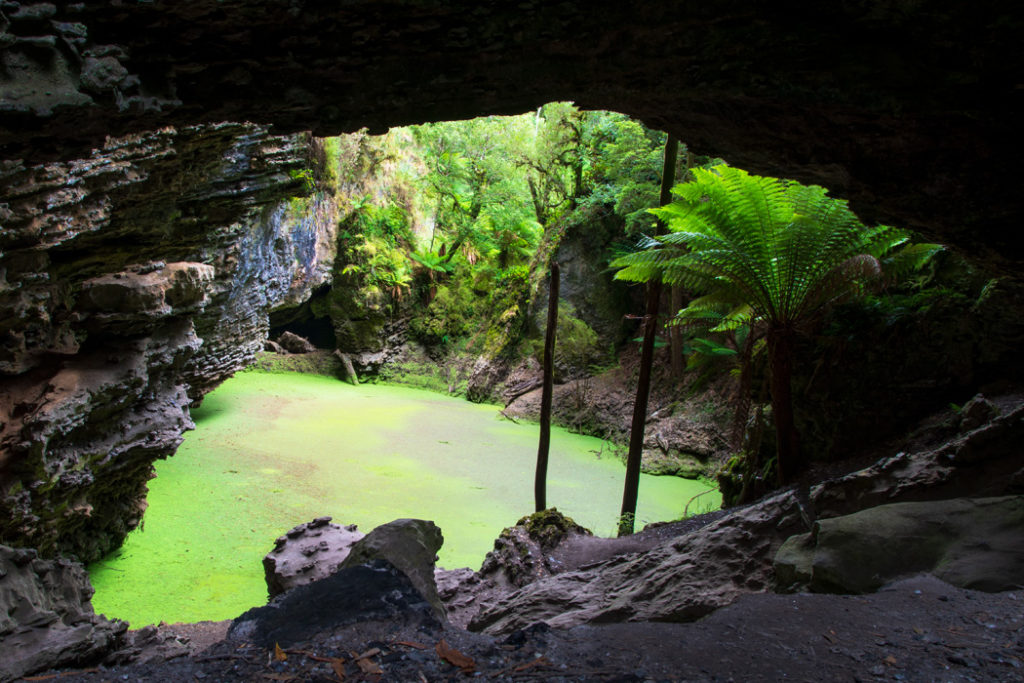
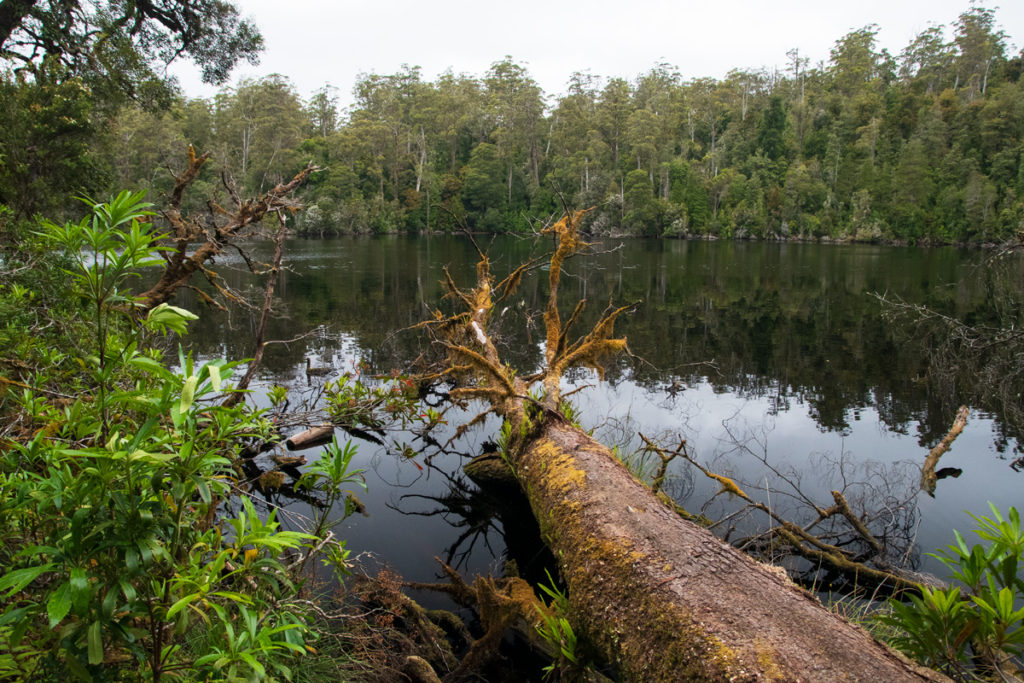
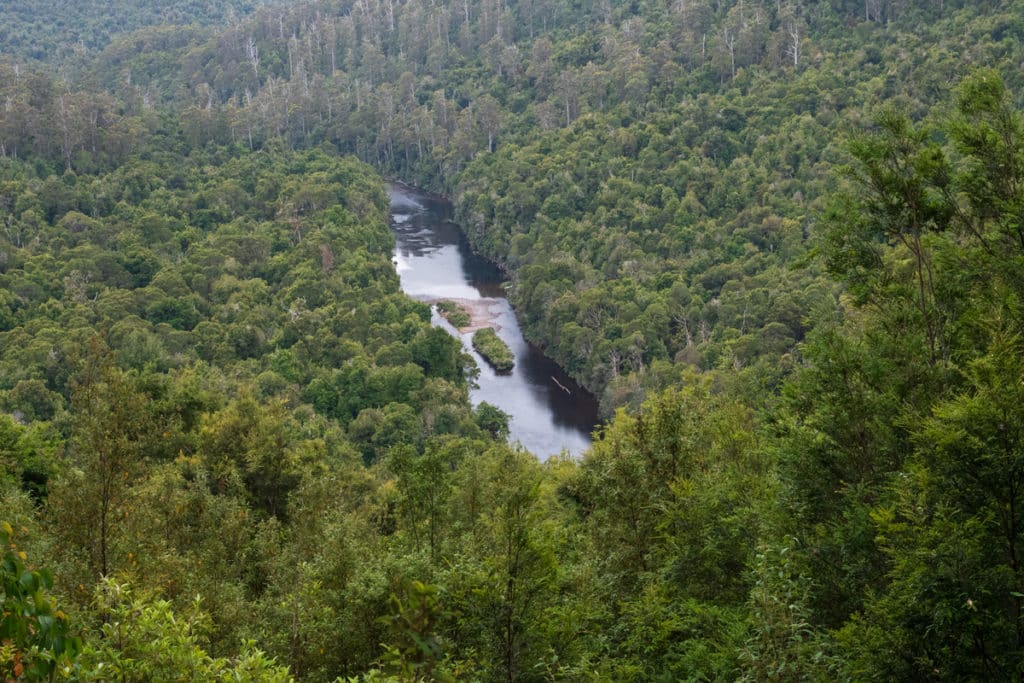

The entire drive is stunning, but here are some unmissable highlights:
- Trowutta Arch – Green algae-covered sinkhole with a limestone arch above it
- Lake Chisholm – A trail through magical mossy rainforest with impossibly-tall trees to a mirror-like sinkhole lake
- Samouc Viewpoint – A sweeping view of Tarkine rainforest and wild Arthur river flowing below
- Balfour Trail – An old pack-horse trail through lush and wild rainforest.
- Edge of the World – A 180-degree panorama of the rugged Tarkine coastline
Tarkine Drive travels through some remote country and there are no petrol stations or shops on the drive, apart from the small general store in Arthur River. The best place to stock up on groceries and fill up your car is Smithton (21km from Stanley and 30 km to the start of the Tarkine Drive). There is a large Woolworths supermarket in town.
To find out about all the attractions of the Tarkine Drive and to get the tips for the drive, check out my guide to Tarkine Drive 2 Day Itinerary.
Where to stay on Tarkine Drive
Because of its remoteness, there aren’t many accommodation options on Tarkine Drive. Your choices are Rodger River (rainforest section) and Arthur River (coastal section).
At Rodger River, there is the cozy Tarkine Grove cottage. It is located on farmland adjacent to the rainforest. At Arthur River, check out the units at Sunset Holiday Villas, and a few different apartments at Arthur River Lodge: Upstream apartment, Downstream apartment, or Entire House.
Boat Harbour and Sisters Beaches
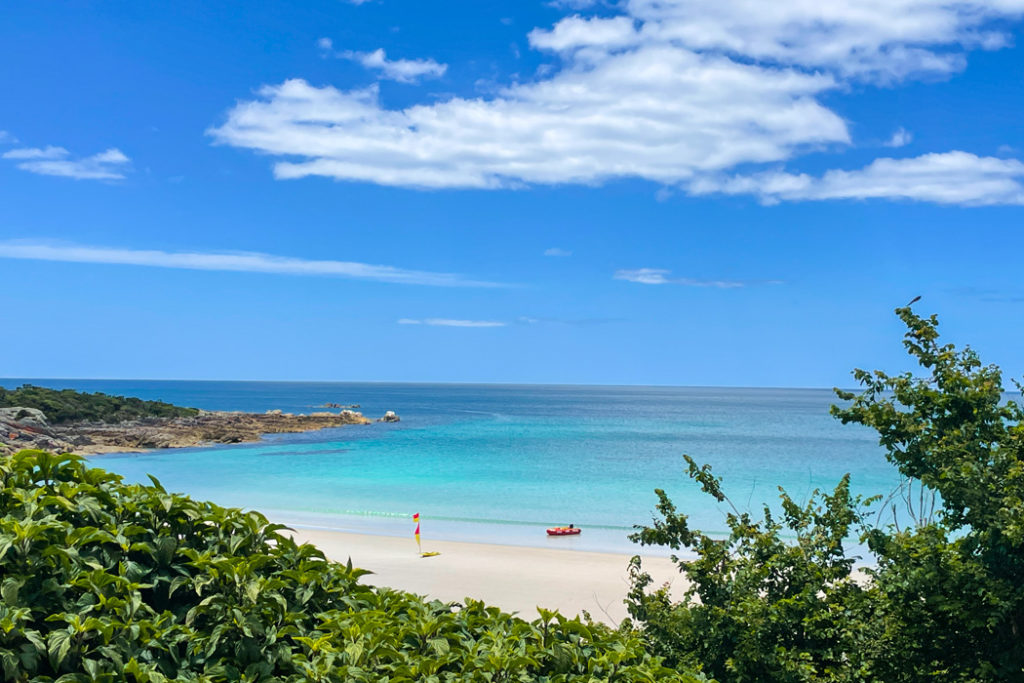
From the Tarkine, it’s time to return to the coast and start exploring the idyllic north western coastline. We spent the night in Stanley, because we were absolutely in love with this adorable town, and because it’s a convenient starting point for the drive along the Bass Strait.
One of the most beautiful beaches in Tasmania, Boat Harbour Beach is sheltered in a cove just 50 km east of Stanley. You start seeing glimpses of its heavenly-coloured waters from Port Road that connects the beach to Bass Hwy.
I never expected a Tasmanian beach to look so deceptively similar to the Maldives or the Philippines until I saw the impossibly clear water of the Boat Harbour Beach. It’s hard to fight the temptation to wade in the bitingly cold water when it looks so inviting.
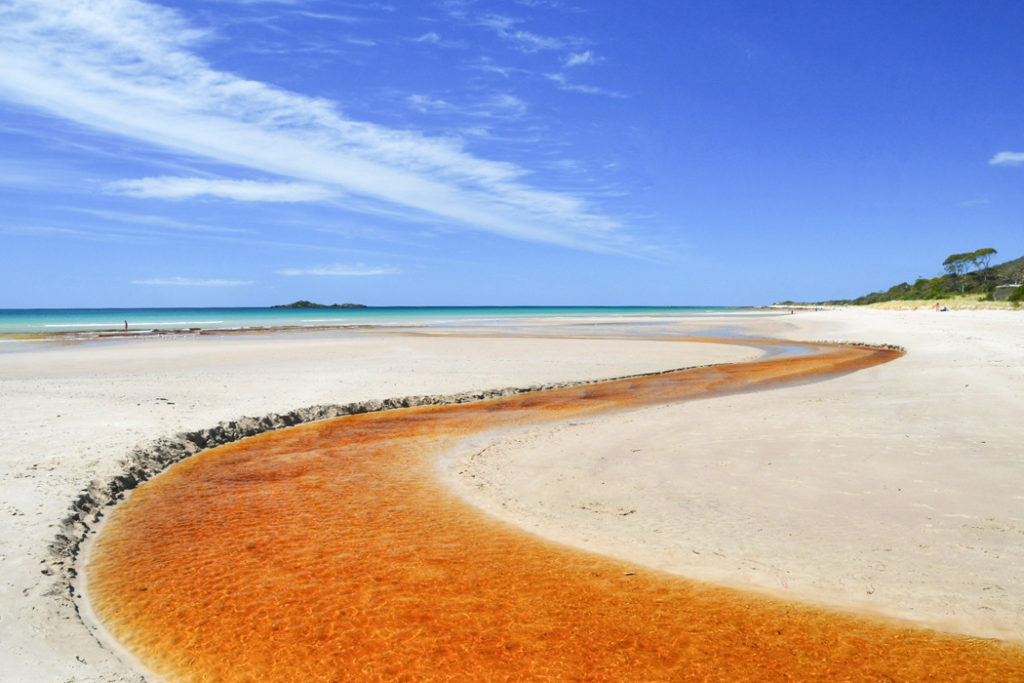
The trade-off for this beauty is that Boat Harbour Beach is crowded, which feels weird in this part of Tasmania. To get away from the crowds, take a 10-min drive to Sisters Beach. This hidden gem is equally stunning plus there is a beautiful brown-tinted creek snaking across the beach towards the surf. It’s a mesmerizing spot.
Wynyard
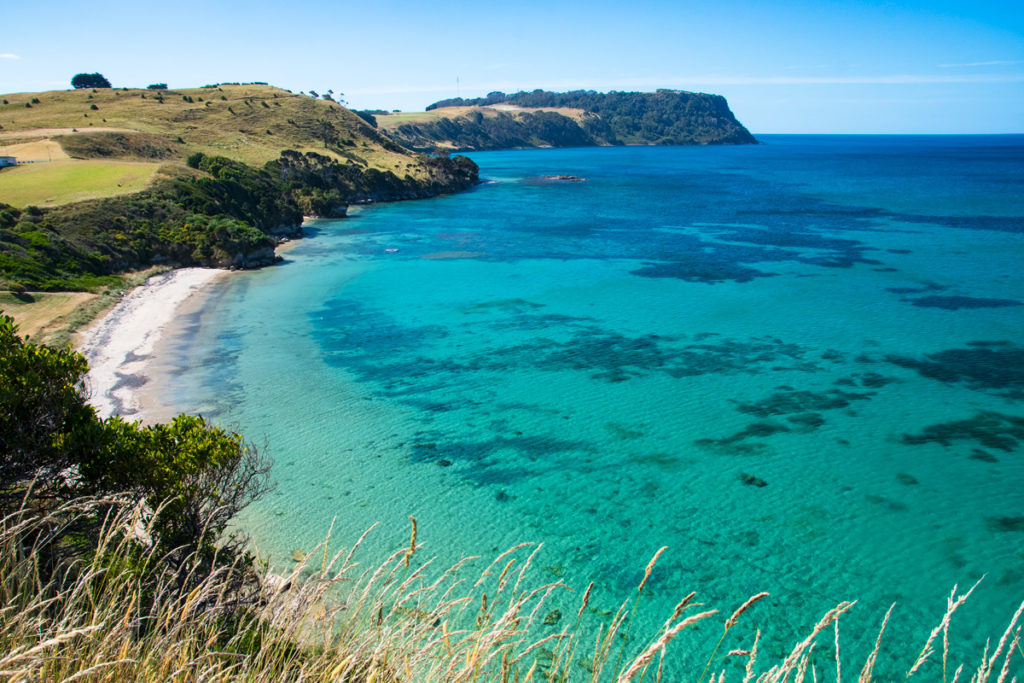
Another 17 km east along Bass Hwy, Wynyard is a lovely seaside town and a good base for staying overnight. It’s a much nicer town than the better-known but less attractive Burnie.
One of the most interesting spots in Wynyard is the Fossil Bluff which is an area of exposed cliffs next to the beach, with thousands of little fossilized shells embedded in the rocks. There is also a trail leading from the beach to the top of the headland where you get an expansive panorama of the coastline and lovely views of Wynyard spreading along the banks of the Inglis River.
If you are not prone to vertigo, follow a faint trail into the bushes towards the edge of the cliff. The view of the beach from the cliff is mesmerizing.
If you do stay overnight in town, join a Penguin watching tour with the local guide. It’s a much more intimate alternative to the Penguin watching platform in Burnie.
Where to stay in Wynyard
Wynyard is home to one of my favourite accommodations in north west Tasmania – the Coastal Pods. It’s incredible what a good designer can do with a couple of shipping containers thrown together. My next top pick is the beautiful Lylah’s By The Sea three-bedroom house nestled between the mouth of the Inglis River and the ocean. It is only a few minutes walk to the beach or to the cafes in town
Penguin
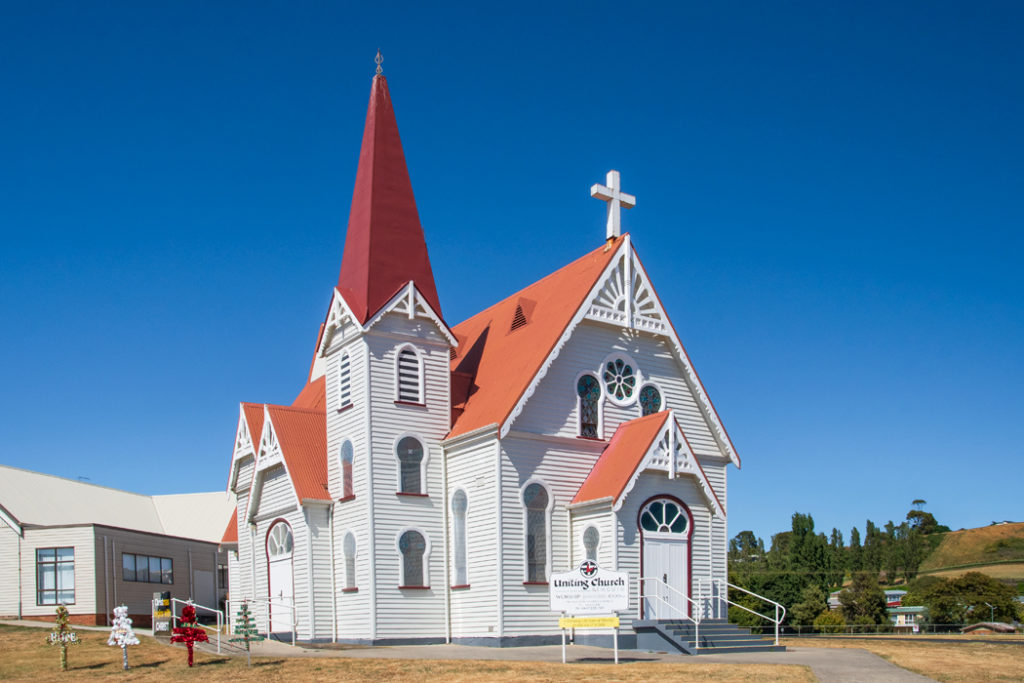
Penguin is a quirky and delightful little coastal town 36 km east of Wynyard. If you are into penguins, you will lose yourself photographing penguin murals, penguin street signs, penguin-themed rubbish beans and children playgrounds.
If the penguin is not your spirit animal, go for a stroll along the foreshore, admire the beautiful Uniting Church, see the 3.15 meter-tall Big Penguin, and visit Penguin general cemetery for a wander among the colonial tombstones and for sweeping views of the Bass Strait.
If you are visiting between November and March, you can watch the actual penguins, the Fairy kind, waddle onto shore after nightfall at Penguin Point.
Ulverstone
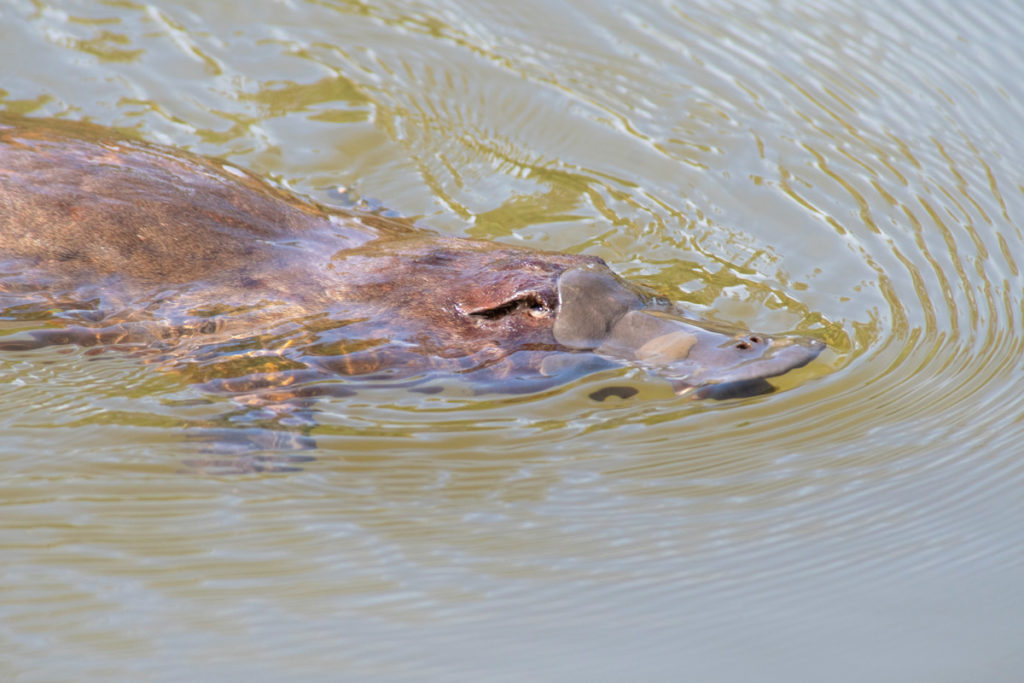
Ulverstone is one of the bigger towns and it is another convenient base for exploring the area (unless you prefer to stay in the much quieter Penguin 13 km west). Sites like the Gunns Plains Cave and Leven Canyon are easily visited from Ulverstone on a day trip.
But there is also a local secret nearby – the Tasmanian Arboretum in Eugenana that is the absolute best place to see Platypus in the wild in Tasmania. Unlike in most places where platypus are generally active at dawn or dusk, at the arboretum, they are active at all hours of the day.
No one knows how the platypus discovered the Founders lake at the arboretum, but once they did, about a dozen of them travelled up the creek and settled at the lake. And they must be feeling pretty safe there. So much so that you are virtually guaranteed to see a platypus in the arboretum. We had about a dozen sightings in two hours and at one time, we could see three different platypus simultaneously. You can find more details in my guide to Watching Platypus in Tasmanian Arboretum.
By way, there is no consensus on the correct collective noun for platypus. Merriam Webster dictionary suggests using platypuses or platypi. However, in scientific and conservation contexts, the term platypus is used as the plural of platypus.
If you are looking for things to do in Ulverstone itself, visit the quirky garden maze on Maud Street. Not only is it a curious garden, but you also get stunning views of the town and the coastline. There are also lovely sandy beaches sprawling on each side of town.
Where to stay in Ulverstone
My top pick for Ulverstone is the three-bedroom Leven River Retreat villa perched in a gorgeous spot on the Leven River, 1 km from the beach. If you are looking for a smaller place, the self-catered 2-bedroom Ulverstone Waterfront Apartments are also right on the river. And if you don’t mind staying further from the beach, consider the award-winning Boscobel of Tasmania B&B with stunning interiors and a delightful garden with gorgeous old trees. Alternatively, check all accommodation options in Ulverstone for your dates.
Port Sorell & Narrawntapu National Park
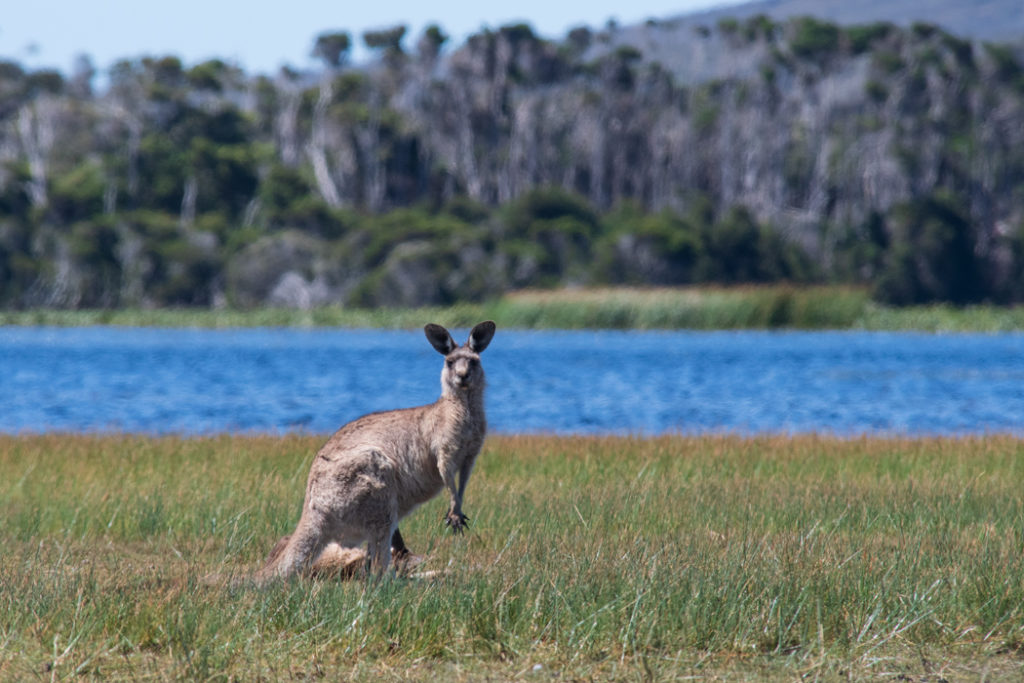
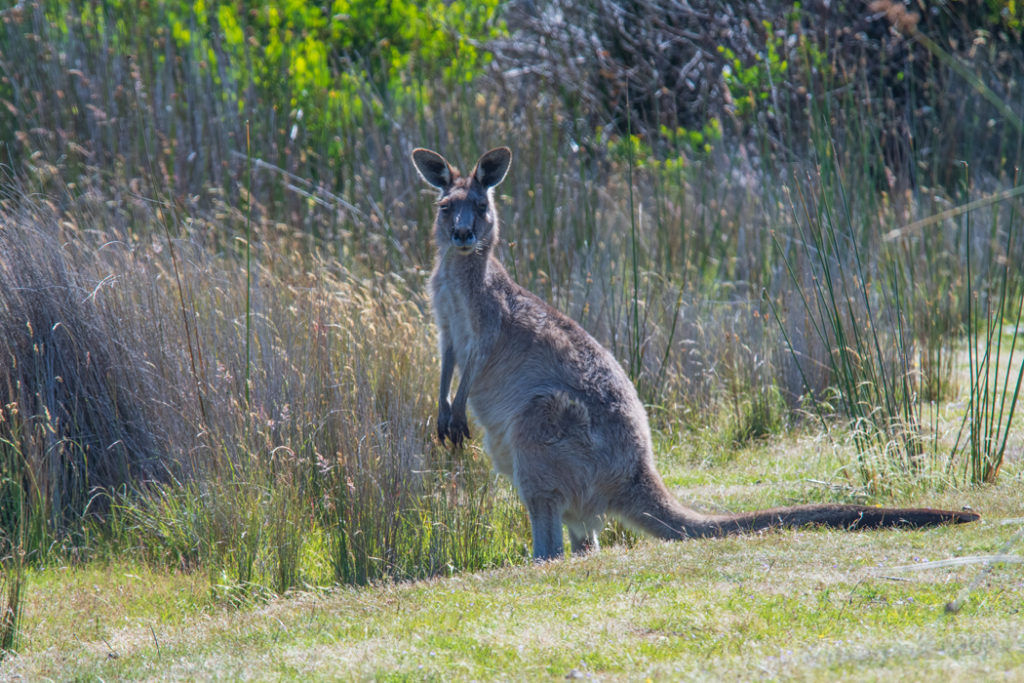
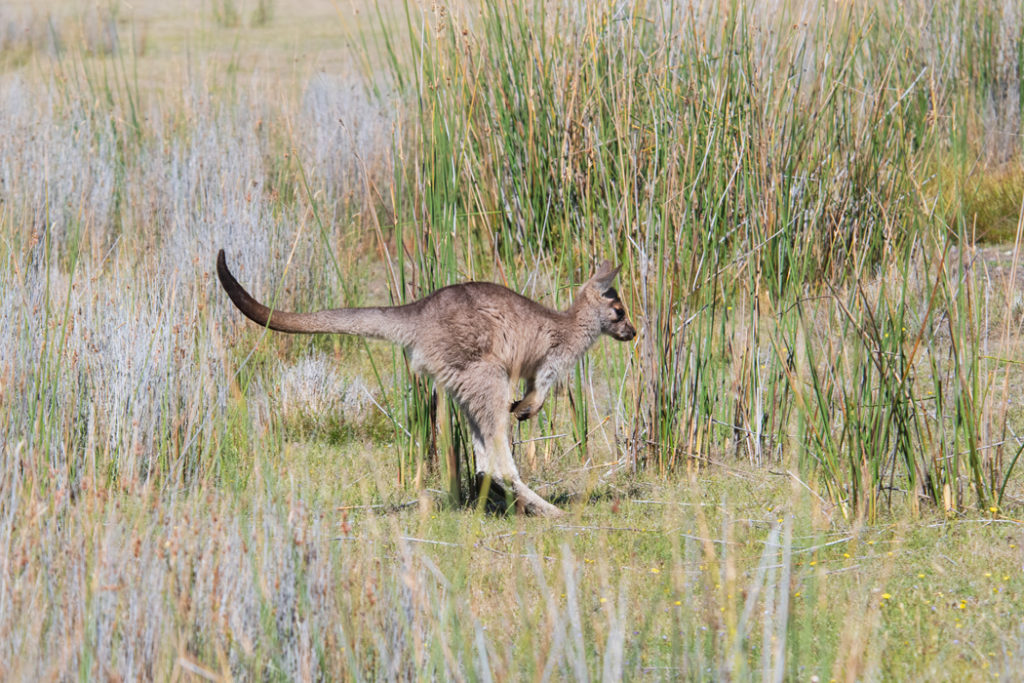
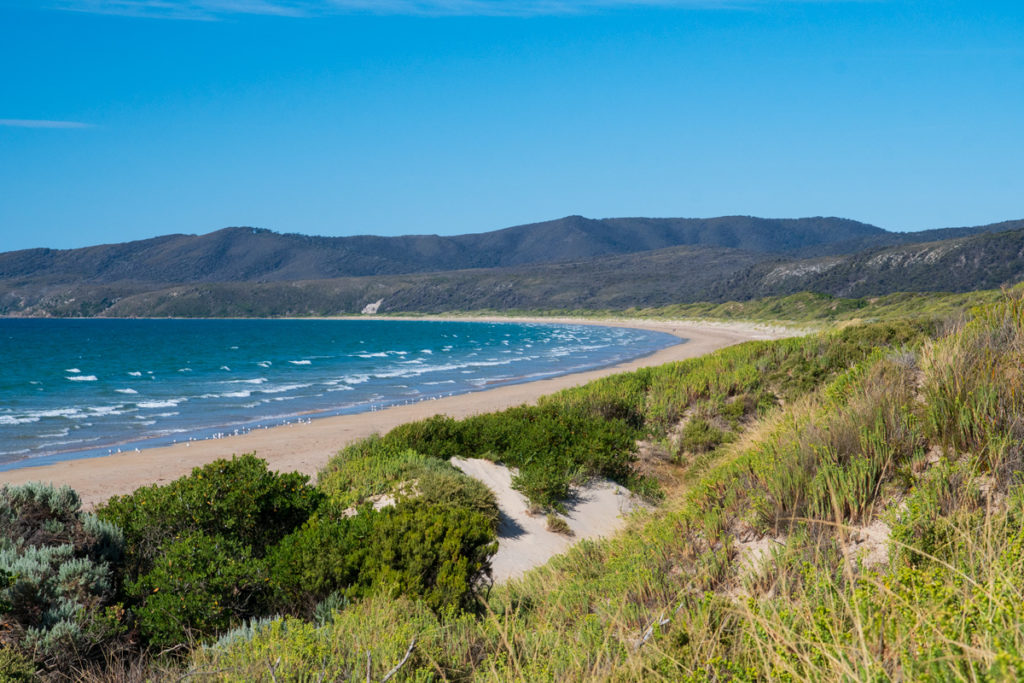
Port Sorell is the easternmost point of north west Tasmania, 40 km east of Ulverstone. It is a lovely seaside town with plenty of wildlife around. The Rubicon Estuary is an Important Bird Area and Narawntapu National Park on the other side of the estuary is one of only a few places in Tasmania where you can see Forrester kangaroos – Tasmania’s own subspecies of Eastern Grey Kangaroo.
Port Sorell is surrounded by stunning beaches: Shearwater and Hawley Beaches, and Bakers Beach in Narawntapu. But keep in mind that to enter Narawntapu National Park you’ll need to purchase your Parks Pass at the Visitor Center.
There are three trails starting from the Visitor Center area, or three ways to walk one trail, to be more precise. The 4.8 km Springlawn Nature Walk meanders through a lovely paperbark forest, around the Springlawn lagoon. There is a bird hide along the way, which can be your turn-around point if you prefer a shorter walk (about 30 min).
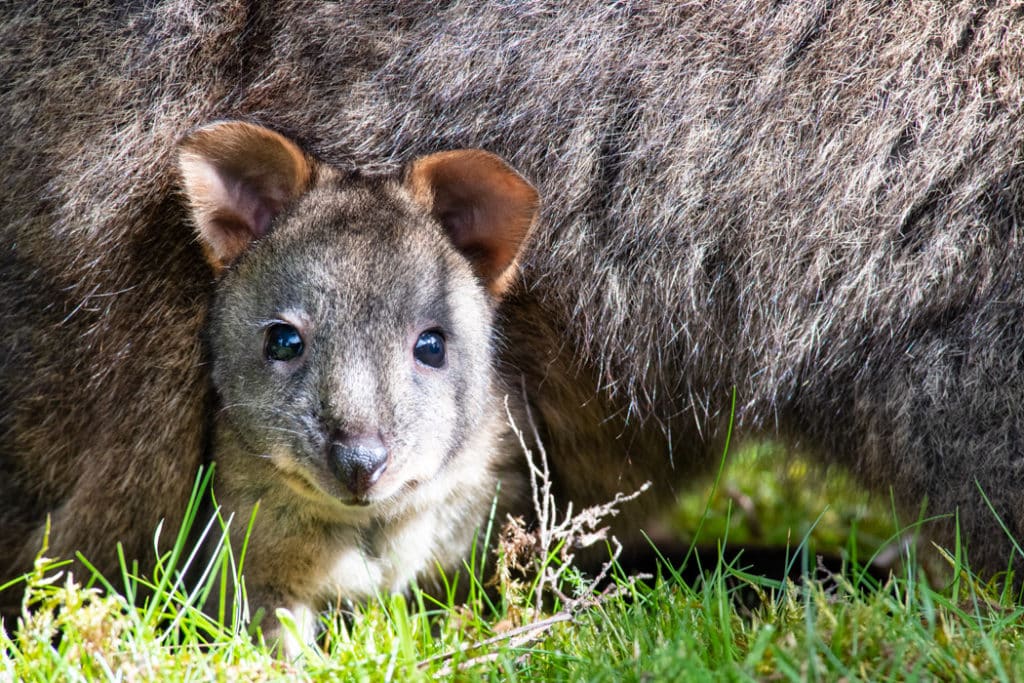
If you continue around the lagoon, the grassland that you walk across on the way back is the best place for spotting Forester kangaroos in the park. They like snoozing on the shore of the lagoon here.
You can also extend this walk and climb up to Archers Knob for amazing views of the area. The full trail to Archers Knob is about 9 km return and takes in Bakers Beach. Or if you don’t feel like a long walk, you can drive up to Bakers beach and go for a stroll on the sand.
Narawntapu is an easy day trip from Port Sorell – it’s less than 30 min away. Or you can visit the park in the first half of the day and drive all the way back to Launceston (78 km) in the afternoon.
Where to stay in Port Sorell
Roosters Rest is a cozy property that offers a 1-bedroom cottage or 2-bedroom family bungalow nestled in a serene bush setting, minutes away from a beach. Another popular choice is Tranquilles Bed & Breakfast which offers a selection of rooms and a luxury suite if you feel like a splurge. Check all accommodation options in Port Sorell for your dates.
Final Thoughts on North West Tasmania
If you are looking for a place to get away from it all and to be spellbound more often than not, north west Tasmania is just that kind of place. The region has it all: epic nature, adorable wildlife, scrumptious food, delightful towns, beautiful people, and an incredibly relaxed atmosphere. It’s quieter and slower than the east coast but more accessible than the west.
It is this unique combination of remoteness and accessibility that makes north west Tasmania so enjoyable to explore. The roads in this part of the state are as good as everywhere else in Tasmania and without much traffic they are easy to drive on, even if you are used to driving on the other side of the road.
More Tasmanian Nature and Wildlife Destinations
- Sea caves and wildlife of the inhospitable Tasman Peninsula
- Hastings Caves and Southern Forest – a journey to Far South Tasmania
- 4 Great Short Walks in Freycinet National Park
- 15 Things to Do in Stanley – Tasmania’s Prettiest Small Town
- The Absolute Best Place to See Platypus in Tasmania
- Leven Canyon – Tasmania’s Hidden Gem
- Gorgeous Beaches in Tasmania: North-West Coast
- Visiting Gunns Plains Caves in North West Tasmania
- Travel Guide to Edge of the World, Tasmania
- Mountain Valley Wilderness Holidays Review

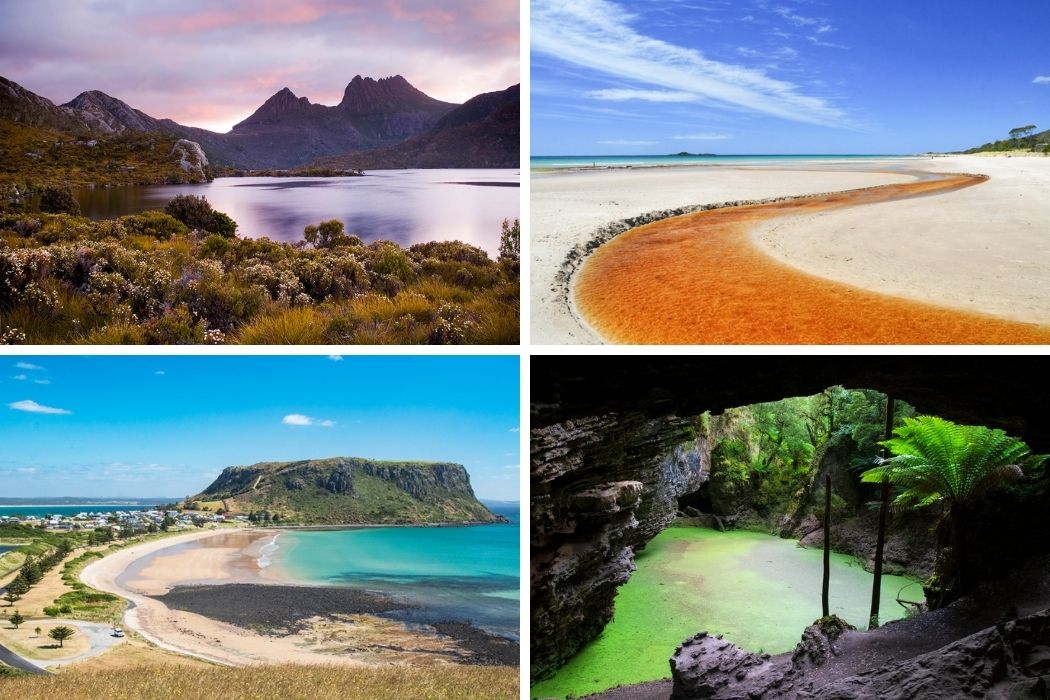
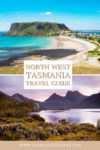
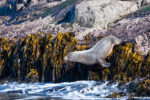
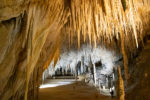
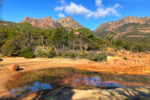
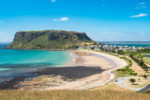
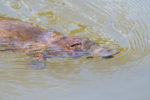
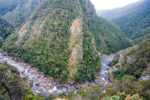
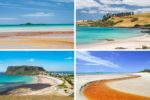
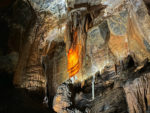
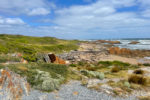
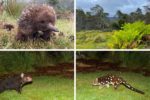
Flipping ‘eck Margarita! You always see the best Tasmanian wildlife, and take the most impressive photos! This post is not exception! I just love it when I see you have a new post. <3
In addition to the fuzzy faces, the scenery is fabulous too! Sisters Beach, Fossil Bluff beach and Leven Canyon are breathtaking.
Thank you Josy! North west Tassie is spectacular. I knew it would be but it still took me by surprise.
Wow, this looks like the trip of a lifetime! My husband has been to Tasmania as a kid, but always talks about going back as an adult so he can appreciate it all a bit more. The wildlife and landscapes are one of a kind! The Mountain Valley Wilderness Holidays look like a true hidden gem. Saving this for next time we are visiting family in Australia – hopefully we can extend for this North West Tasmania Road trip!
Thank you Susanna, I hope you do visit Tasmania. All of the state is drop-dead gorgeous. But north west is particularly striking. If you enjoy seeing animals in the wild, I definitely recommend spending a couple of nights at Mountain Valley Wilderness cabins.
Wow what a gorgeous region to see! The Mole Creek Caves and Cradle Mountain are incredible, especially the landscape views. I’d love to spend a few days lounging on the beaches of Stanley and Wynyard! And of course seeing wombats and wallabies!
Those caves look incredible to visit! The whole area looks like it’s filled with unique locations to explore.